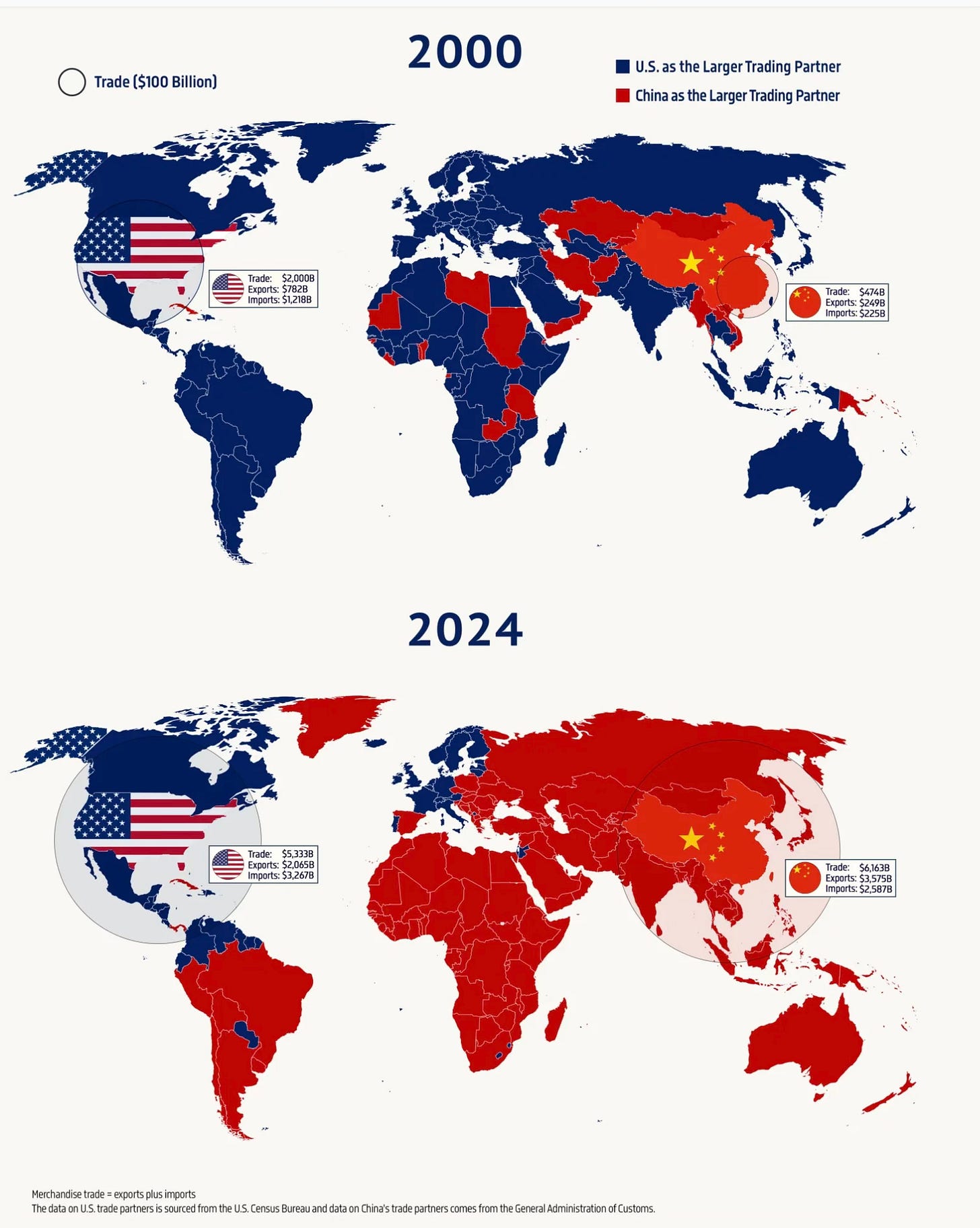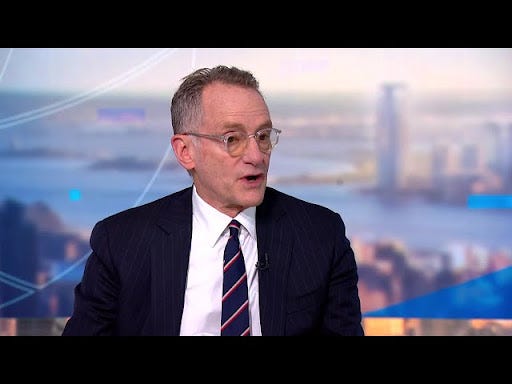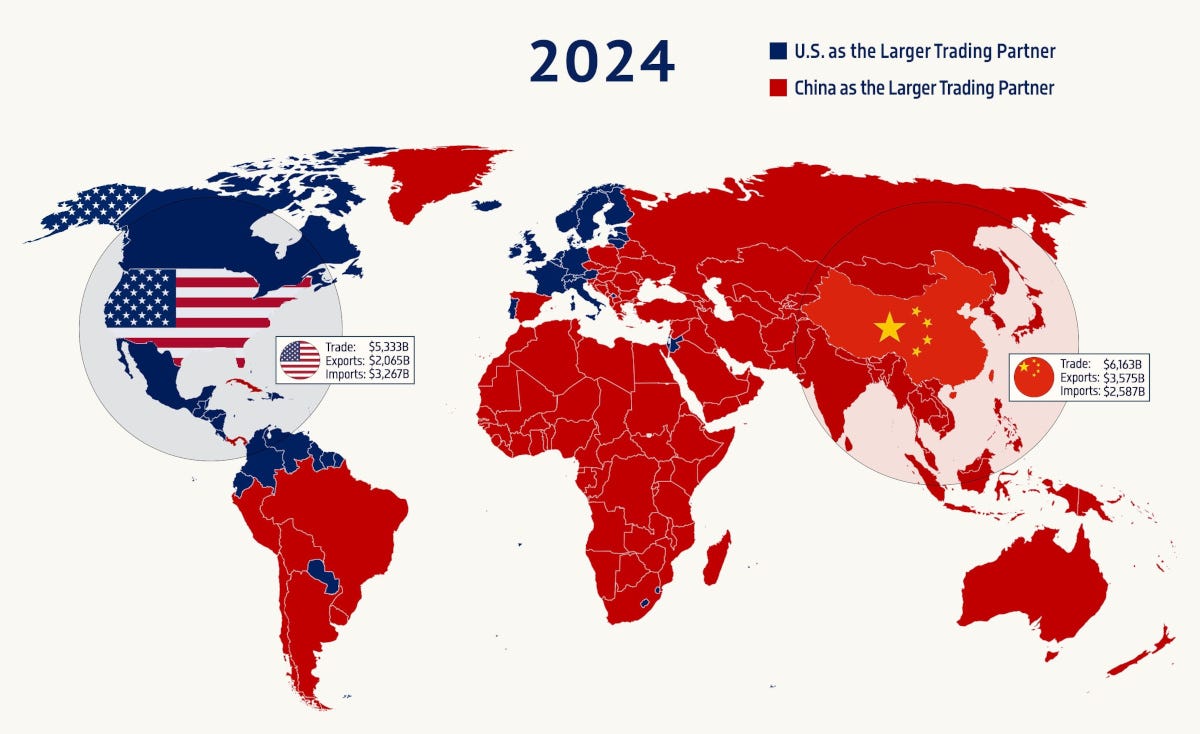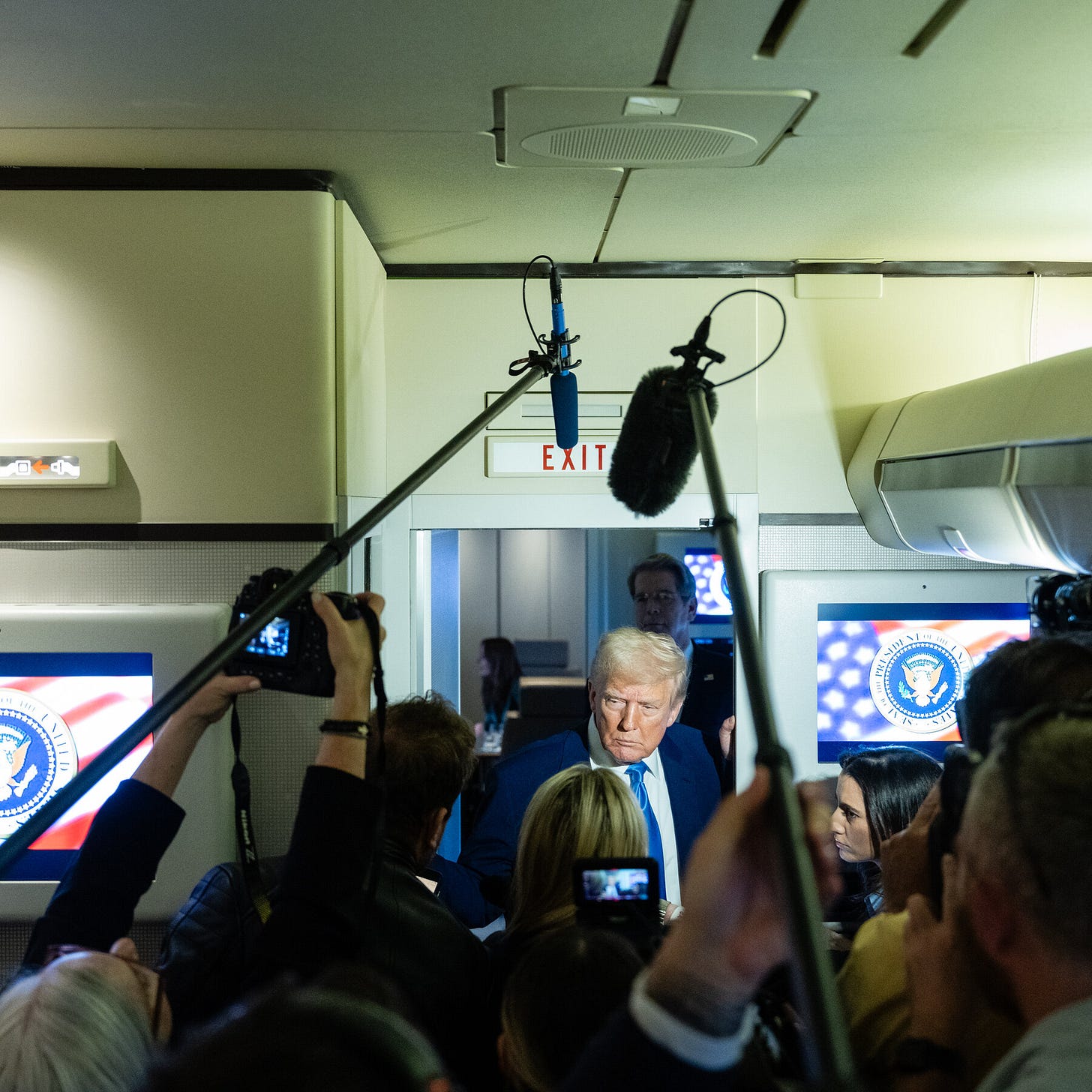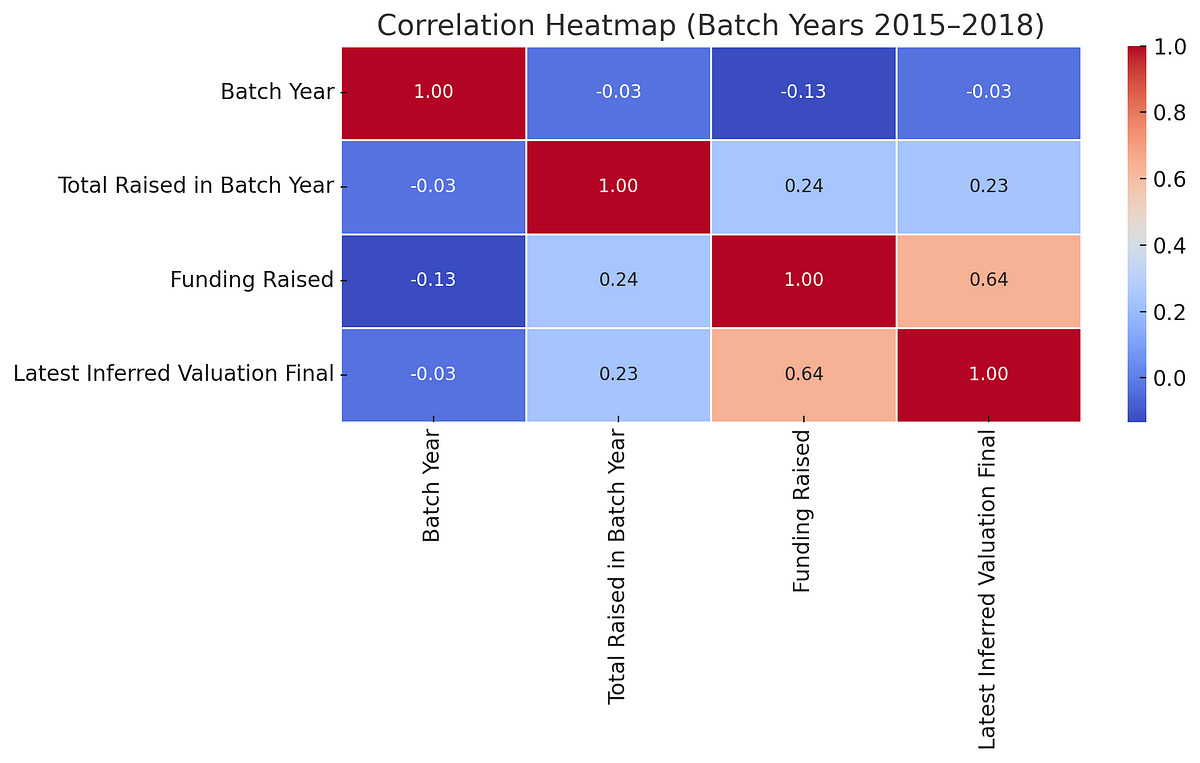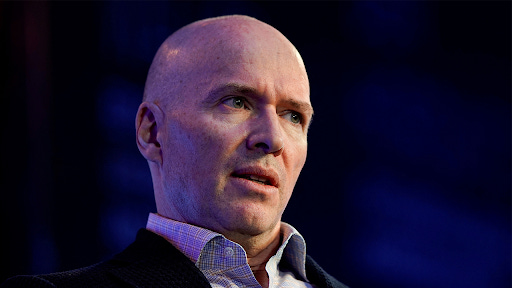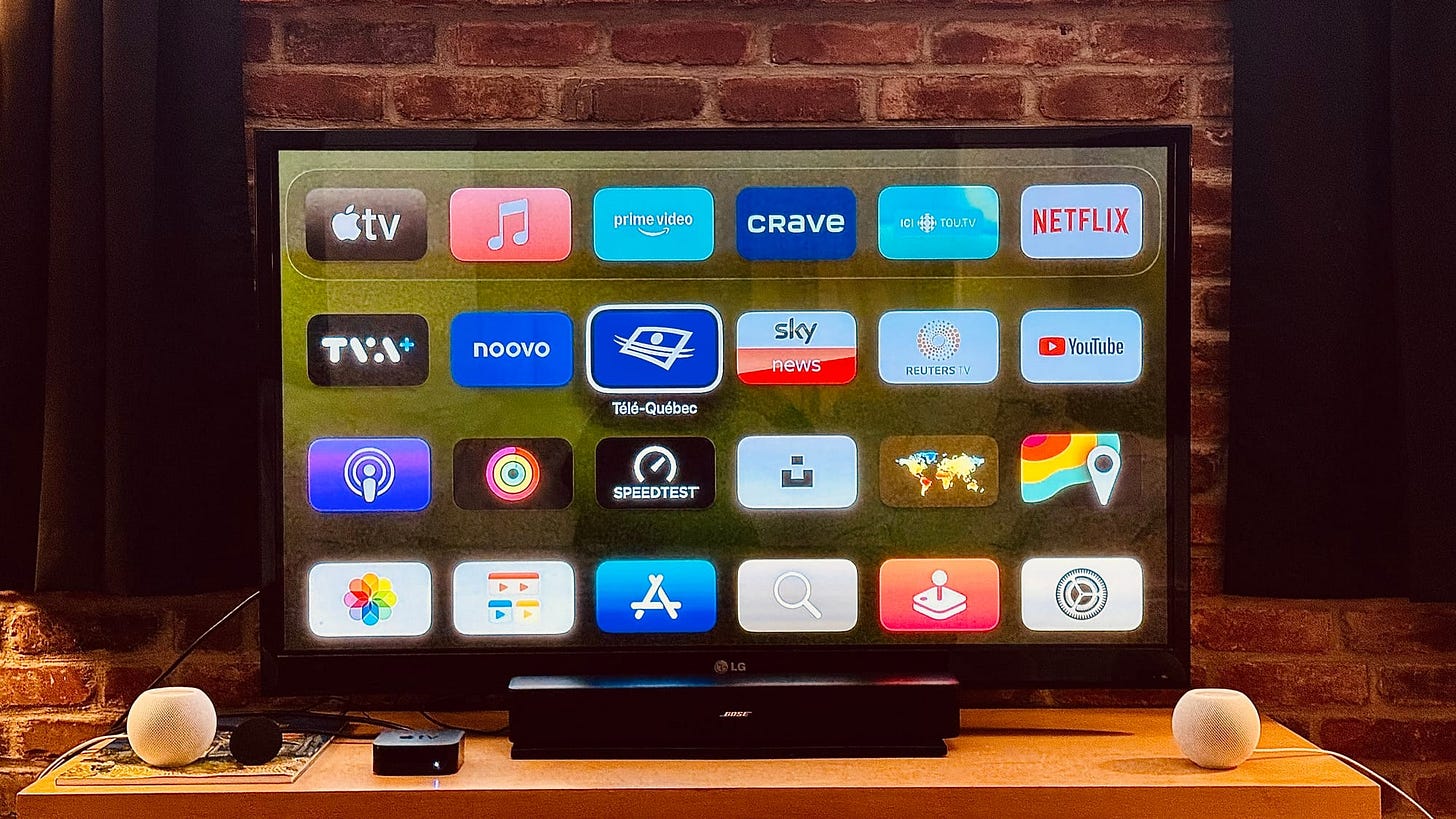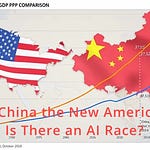Contents
Editorial
Whiplash: The World Isn't Ending. But the 'West' is.
Essays
Mapped: How China Overtook the U.S. in Global Trade (2000–2024)
If Trump is trying to suppress China, he’s going about it all wrong
How AI Will Enhance Human Potential, Not Replace It: Reid Hoffman
Geopolitics
How Trump’s TikTok Negotiations Were Upended by China and Tariffs
The self-inflicted death of American science has already begun
Trump Cuts Most Tariffs to 10% but Increases Tariffs on China to 125%
Trump, Supposedly, Thinks the U.S. Has the ‘Resources’ Needed to Make iPhones
Regulation
AI
The Power of Context: How Graph Technology is Reshaping AI and Decision-Making
China gains dexterous upper hand in humanoid robot tussle with US
The AI magic behind Sphere’s upcoming 'The Wizard of Oz' experience
Shopify CEO Requires Proof Jobs Can’t Be Done by AI Before Adding Headcount
Google says it’ll embrace Anthropic’s standard for connecting AI models to data
Venture Capital
Rethinking Unit Economics: How AI Agents Are Rewriting The SaaS Playbook
Express Trains and Warp Zones – The Bifurcation of the VC Market
North America Startup Investment Spiked In Q1 Due To OpenAI, But Seed And Early Stage Fell
Why Senior VC Partners Are Leaving Big Firms for Smaller Funds
Media Innovation
How NFL’s New 8k “Hawk Eye” Cameras Offer an Interesting Model for Truth and Verification
Established Writers Are Making More Money After Leaving Substack
Private Indexes in Public Markets
Startup of the Week
Interview of the Week
Keach Hagey on Sam Altman's Superpower
Post of the Week
Whiplash
Editorial: Whiplash: The World Isn't Ending. But the 'West' is.
The concept of the ‘West’ has been in existence since shortly after the end of World War II. It describes the post-war order of the USA and its allies against the ‘East’. It consisted of an economic, political, and military arrangement and had nothing to do with geography. It included the dominance of the Dollar as the reserve currency of the world, initially backed by Gold and then not.
It symbolized an American-led world order that included Japan, Korea, and in the period since the collapse of the Soviet Union, many Eastern European nations.
The nature of US world leadership has been impacted by the changing balance within the global order, led by economic changes. See this graphic from Visual Capitalist (article below).
The share of world GDP accounted for by the USA has shrunk and so to its share of world trade.
Weakening nations have historically favored protectionism. Strengthening nations, especially economic global leaders, have historically favored free trade. The US began moves towards protectionism well before the current Government, but now the tipping point has arrived.
2025 represents the end of the ‘West’. USA first replaces the ‘West’ as an organizing principle. The on-again, off-again whiplash of tariffs and markets is noise. The signal is in the breakup of former relationships and an attempt to reorganize the US’s position in a new fragmented world order.
Attempts to characterize these changes as deglobalization are superficially correct. But only because the USA was the world leader for the past 8 decades. Unchallenged US leadership was the form taken by globalization. Free trade represented its strength in the context of economic growth. The end of US world leadership is the end of globalization in that definition. But actually, we are about to experience a new global order.
The next phase of the global order will be made up of the same players, but playing different roles. China is already a global giant and growing. Asia as a whole is bigger still and a center of manufacturing as well as technology. Consumption inside Asia will be larger than the rest of the world as a whole.
Global (and US) GDP is not going to shrink. Indeed it may grow faster under the rise of AI than ever before. But a shrinking percentage of it will be made in or revert to the USA.
Looked at from this point of view Trump’s tariffs, and the direction they represent, is rational. The USA has to do what the UK learned to do over the past century, play defense and accept not being the sole world leader. This may slow down the change to a new global order, but not stop it.
In this context, ideological memes can be confusing. It is worth remembering some truths.
Global trade is a human good.
GDP grows more if trade grows.
The local share of global GDP is a measure of success in making and selling things
Policies to protect local economies from global competition are a symptom of weakness, not strength
As individuals, we want good products at the best price. This requires a global market.
My point of view is that humanity wants to be global. That is an economic truth and can live alongside social and political preferences that are intensely local. In the same way, technology wants to be global. The Internet and the smartphone were not local but instantly global. The same is true of AI. Economic and technical globalization is a bottom-up globalization.
It contrasts with top-down political, economic, and military structures like the World Bank, the United Nations, The EU, NATO, the G7, the G20 and so on that are symbolic of US leadership since World War Two and so only global due to the strength of the US in that time.
So what to think? Trump isn’t wrong to react to these changes to attempt to slow down a long-term trend of US relative decline. However, the future of the world is about bottom-up globalization driven by technology innovation and related markets. World GDP will grow, despite tariffs. US GDP will also grow but more slowly. The US-based AI leaders can play a big role in US performance if they can figure out global growth and monetization. But so too will China’s AI leaders.
This week’s articles are a smorgasbord of content all relevant to these discussions.
Essays
Long Live RSS
Windley | Cory to try one more time | April 7, 2025
#Technology • #Web • #RSS • #SocialMedia • #Newsblur • #Essays
I've stopped using social media apps as much and have started using RSS again. I'm wasting less time scrolling past stuff I don't care about and more time reading things I enjoy. Try it. Like many, I've grown increasingly disinterested in social media over the last year. I still have accounts on X, Substack, Facebook, and others. But I find that there's less and less there that I actually care about. I find myself wading through lots of crap to find the things I want to see. Still, I do like to browse through ideas while waiting in line, at the doctor's office, and so on. This post from Cory Doctorow entitled "You should be using an RSS reader" caught my eye a while ago. I used to use an RSS reader all the time. I've tried to get back into it a time or two, but it didn't stick. Inspired by Cory to try one more time, I downloaded the RSS reader he uses (Newsblur) and gave it another shot. This time I coupled it with moving the RSS reader app on my phone to a more prominent position so when I'm looking for something to browse, I see it first. First I found RSS feeds for some of my friends and publications I like to read. I also discovered that Substack publications have RSS feeds. Many publications don't make finding RSS easy, but it's almost always there. There are a few authors I like on The New Stack and I found that if you enter /rss after the URL for an author or category page, you get RSS for that author or category. For example, here's the RSS page for Jon Udell. Cool. After adding RSS feeds for things I like (most online publications have one), I started reading things on Newsblur instead of opening up a social media app. Most newsreaders don't have an algorithm. If they do, it is not usually the default setting and can be turned off. If you subscribe to too many feeds, turn it on and let it prioritize your reading. But regardless, you control the experience. Just like you should. Cory's right, using an RSS reader will make your digital life better. I'm wasting less time scrolling past stuff I don't care about and more time reading things I enjoy. That's a win.
Globalization Is Collapsing. Brace Yourselves.
Nytimes | April 5, 2025
#Politics • #Globalization • #EconomicPolicy • #InternationalRelations • #Nationalism • #Geopolitics • #Essays
The article discusses the potential collapse of globalization, drawing parallels with historical events where global interconnectedness unraveled.
This collapse is not unprecedented; the world was similarly intertwined 100 years ago, and its unraveling led to disastrous consequences. The question posed is whether we can avoid a similar outcome today.
Historical Context and Current Trends Historically, globalization has been a recurring phenomenon, with periods of increased global integration followed by periods of fragmentation. The early 20th century saw a significant decline in globalization due to political tensions and economic protectionism, culminating in the Great Depression and World War II. Today, similar forces are at play, with rising nationalism, trade barriers, and geopolitical tensions threatening the current era of globalization. Key factors contributing to this trend include:
Rise of Nationalism: Many countries are adopting more nationalist policies, which often lead to protectionism and reduced international cooperation.
Trade Tensions: Increased tariffs and trade disputes between major economies have disrupted global supply chains and reduced economic interdependence.
Geopolitical Conflicts: Escalating tensions between major powers are creating an environment where international collaboration is increasingly difficult.
Implications and Potential Outcomes The collapse of globalization could have profound implications for economies, societies, and international relations. Economically, reduced trade and investment could lead to slower growth, higher prices, and reduced economic opportunities. Socially, it could exacerbate inequalities and reduce cultural exchange. Politically, it could lead to increased conflict and instability. The article suggests that understanding the historical context and learning from past mistakes could help mitigate these outcomes. However, the complexity of current global challenges means that finding solutions will be difficult.
Conclusion In conclusion, the potential collapse of globalization is a pressing concern, with historical precedents suggesting severe consequences. Understanding these dynamics and working towards international cooperation could help prevent or mitigate the negative impacts of such a collapse.
The future of globalization depends on the ability of nations to navigate these challenges and find a path towards sustainable and equitable global integration.
How to Think When the World Doesn’t Make Sense
Beehiiv | the old rules. | April 10, 2025
#Business • #Strategy • #Globalization • #Investment • #Inflation • #Geopolitics • #Essays
The Shift to Protectionism On April 2, 2025, President Donald Trump announced a significant shift in U.S. trade policy, dubbing the day "Liberation Day." This involved sweeping tariffs, including a universal 10% tariff on all imports and a significant 54% cumulative tariff on Chinese goods. These measures marked a break from decades of globalization, signaling a turn towards protectionism. The global market reaction was swift, with the Dow Jones Industrial Average falling by 1,500 points, highlighting fears of a potential global trade war. Despite the panic, Howard Marks, co-founder of Oaktree Capital, provided a calm analysis of these events, emphasizing the importance of "clear thinking in complex times." He argued that this policy shift represents a structural change rather than a cyclical fluctuation in trade economics.
Globalization and Inflation Dynamics For decades, globalization contributed to suppressed inflation by optimizing supply chains and enabling cheaper imports. Marks notes that from 1980 to 2005, prices of durable goods in the U.S. fell significantly due to outsourced manufacturing and global labor arbitrage. The new tariffs counter this trend by increasing production costs and reducing trade efficiencies, leading to a more persistent inflationary environment. This shift poses challenges for investors who relied on the steady, predictable economic landscape created by globalization.
Rethinking Investment Strategies Marks emphasizes the need to adapt investment strategies to the changing economic climate. As the rules of the game alter, relying on past predictions becomes less effective. He advises adopting judgment and context over strict data-driven forecasts. With assumptions about free trade, stable alliances, and cheap capital in flux, investors need to reassess their strategies. Marks highlights the importance of evaluating whether price changes represent genuine changes in risk or mere fluctuations in market sentiment.
Volatility as an Opportunity Rather than fearing market volatility, Marks suggests viewing it as an opportunity for thoughtful analysis and value-driven investments. He advises investors to ask whether price declines reflect changes in underlying value or merely present discounted buying opportunities. This mindset is crucial in navigating today’s erratic market environment.
Positioning Over Predictions In an era where old assumptions like "the U.S. will always outperform" are challenged, Marks advises focusing on positioning rather than predictions. Investors should build resilient portfolios accommodating diverse outcomes, emphasizing fundamentals and durability over speculative gains. He stresses evaluating the price of uncertainty and whether current valuations reflect realistic scenarios or overlook potential risks.
The U.S. as an Investment Destination While Marks acknowledges the U.S. remains a strong investment destination, he notes it is less so than before. The foundations that made the U.S. attractive—predictable legal systems, fiscal discipline, and investor trust—are increasingly under strain. Investors are urged to be selective, not complacent, with their U.S. investments, considering the broader shifts in global economic dynamics.
Mindset as an Investment Tool Marks underscores that in times of global uncertainty, mindset becomes a critical asset. Investors should focus on understanding the evolving landscape rather than clinging to outdated paradigms. He encourages asking better questions and observing market dynamics rather than reacting impulsively to changes.
Key Takeaways Marks' insights serve as a guide for investors facing a world no longer constrained by the old rules of globalization. This shift to protectionism, the structural change towards persistent inflation, and the volatility that comes with it require a rethinking of investment approaches. Marks’ emphasis on context, judgment, and adaptability provides a valuable framework for navigating these challenging times.
Read full article
Oaktree's Howard Marks on Credit Yields, Trump's Tariffs
Youtube | Bloomberg Television | April 10, 2025
#Finance • #Investment • #CreditYields • #Tariffs • #EconomicPolicy • #Geopolitics • #Essays
Oaktree Capital co-Chair Howard Marks recently discussed the health of credit yields and their comparison to equity investments. Speaking on "Bloomberg Open Interest,"
Marks emphasized that credit yields remain very healthy, even in a volatile market environment. He noted that high-yield bonds, for instance, were yielding around 7.2% a few weeks ago but have since increased to nearly 8%, reflecting a higher prospective return due to price declines.
Marks also addressed the impact of the Trump administration's tariffs on the economy and financial markets. He highlighted that despite market turmoil and significant tariff implementations, credit yields have become more attractive compared to equities.
Marks argued that while stocks have historically delivered higher returns, their current valuations are elevated, suggesting lower future returns. In contrast, credit offers a more predictable return, as it is based on contractual obligations and yields that are sufficient to offset potential credit losses.
The discussion also touched on the historical performance of credit instruments. Marks pointed out that even with narrow spreads, credit has historically outperformed risk-free assets like Treasurys. He emphasized that the key consideration should be whether current spreads are adequate to cover expected credit losses, rather than comparing them to historical norms.
In his recent memo, Marks reiterated that credit presents a better deal than equities at current spreads. He believes that the elevated yields offered by credit make it an attractive option for investors seeking predictable returns in uncertain market conditions. Despite the challenges posed by tariffs and market volatility, Marks remains optimistic about the health of credit yields and their potential for providing strong returns relative to other asset classes.
Mapped: How China Overtook the U.S. in Global Trade (2000–2024)
Visualcapitalist | Bruno Venditti | April 9, 2025
#Business • #InternationalTrade • #GlobalEconomy • #China • #US • #Geopolitics • #Essays
The imposition of tariffs by the Trump administration has sparked global discussions about a potential reshaping of the world economy, with countries considering diversifying trade ties beyond the United States.
The measures announced by the White House target several countries, with China being one of the main ones. President Trump pledged to increase tariffs on China by an additional 50% if the country did not withdraw its 34% retaliatory tariffs, which were introduced in response to U.S. tariffs.
In this visualization, creator Ehsan Soltani explores the shift in global trade dominance between the United States and China over the past two decades. The data is sourced from the United States Census Bureau and the General Administration of Customs of the People's Republic of China.
In 2000, U.S. trade totaled $2 trillion—more than four times China’s $474 billion. At the time, China was the primary trade partner for only a handful of countries, including Cuba, Iran, Libya, Myanmar, Mongolia, North Korea, Oman, Sudan, Tanzania, and Vietnam.
From 2000 to 2024, U.S. trade grew by 167% (a 4.2% compound annual growth rate), while China’s trade surged by 1,200% (an 11.3% CAGR), overtaking the U.S. in 2012.
By 2024, total trade reached $5.3 trillion for the U.S. and $6.2 trillion for China. China is now the dominant trade partner for most of Asia, Eastern Europe, the Middle East, Oceania, South America, and Africa. Looking forward, China is expected to continue to deepen its relationships with emerging markets—importing fuels, minerals, and agricultural goods, and exporting manufactured products.
If Trump is trying to suppress China, he’s going about it all wrong
Ft | April 10, 2025
#Politics • #InternationalRelations • #TradePolicy • #EconomicStrategy • #Globalization • #Geopolitics
The article discusses the economic strategies employed by the U.S. government, particularly under former President Donald Trump, in relation to China. It suggests that if the goal is to suppress China economically, the approach being used is ineffective. The article highlights how tariffs and other economic measures have prompted Beijing to refocus on its economic fundamentals.
Economic Impact of Tariffs Tariffs imposed by the U.S. have had a significant impact on China, but not necessarily in the way intended. Instead of weakening China's economy, these measures have encouraged Beijing to strengthen its economic foundations. This includes focusing on domestic consumption and reducing reliance on exports. The tariffs have also led to increased investment in technology and innovation within China, as the country seeks to become more self-sufficient.
Strategic Shifts in China's Economy China's strategic shift towards economic self-sufficiency is a key takeaway from the article.
This involves:
Domestic Consumption: China is focusing on boosting domestic consumption to reduce its reliance on exports. This strategy aims to stabilize the economy and make it less vulnerable to external pressures.
Technological Advancements: There is a significant push towards technological innovation and development. This includes investments in sectors like renewable energy, advanced manufacturing, and digital technologies.
Economic Diversification: China is diversifying its economy by promoting service sectors and reducing dependence on manufacturing exports.
Implications and Analysis The implications of these economic strategies are multifaceted. On one hand, they demonstrate China's resilience and ability to adapt to external pressures. On the other hand, they pose challenges for countries like the U.S. that have traditionally relied on trade with China. The article suggests that if the goal is to suppress China's economic growth, current strategies may need reevaluation.
Conclusion In conclusion, the article highlights the unintended consequences of economic measures aimed at China. Instead of weakening China, these measures have prompted the country to strengthen its economic foundations. This strategic shift towards self-sufficiency and technological advancement poses new challenges for global economic dynamics and highlights the need for a reevaluation of international economic strategies.
How AI Will Enhance Human Potential, Not Replace It: Reid Hoffman
Thegeneralist | Mario Gabriele | April 8, 2025
#Technology • #AI • #Innovation • #Ethics • #HumanAmplification • #Essays
Reid Hoffman thinks AI won’t take our jobs — it’ll give us superpowers.
Here’s why he’s betting on a future of human amplification, not obsolescence. For decades, science fiction has painted AI as humanity's downfall, depicting scenarios like killer robots, surveillance states, and the end of human agency.
However, Reid Hoffman, co-founder of LinkedIn and a prominent figure in the tech industry, presents a different vision for AI's future. He believes that AI will enhance human potential rather than replace it. Reid isn't just theorizing about AI; he's actively involved in shaping its future.
As a co-founder of LinkedIn, a former OpenAI board member, and founder of multiple AI startups, he has played a significant role in the technological landscape over the past two decades. His latest book, *Superagency: What Could Possibly Go Right with Our AI Future*, offers a compelling case for AI optimism grounded in deep thinking and practical experience. In discussions, Reid shares why he’s optimistic about AI’s potential, how it can foster human creativity, and what steps are needed to ensure technology works for humanity's benefit.
The conversation with Reid explores several key themes, including why he wrote *Superagency* and his belief that AI leads to more human agency, not less. He also delves into philosophical questions about AI's reasoning capabilities and how generative AI can promote collaboration and creativity over passive consumption.
Additionally, Reid discusses preserving humanity's essence as transformative technologies like gene editing and neural interfaces become mainstream. He offers an optimistic view of synthetic biological intelligence as a symbiotic relationship and suggests that AI agents can deepen human friendships rather than replace them. Reid’s perspective on AI is not just theoretical; he actively uses AI in his daily life. He emphasizes the importance of thoughtful regulation and the need for more optimistic science fiction to inspire positive visions of AI's future.
His work challenges conventional fears about AI, inviting readers to view the future through a lens of opportunity rather than fear. This approach is a call to action, encouraging people to embrace AI with excitement and actively shape a world where human ingenuity and AI combine to create something extraordinary.
Reid Hoffman's vision for AI is encapsulated in his concept of "homo techne," where technology enhances human capabilities, making us more human. He advocates for preserving genetic diversity to safeguard humanity and believes that AI can help address some of the world's most pressing challenges. His optimism about AI's potential to unlock new levels of creativity, productivity, and problem-solving is shared by other tech visionaries, who see Superagency as an essential guide for navigating the future of AI. Overall, Reid Hoffman's perspective on AI emphasizes its potential to enhance human potential rather than replace it. By focusing on the opportunities AI presents, he encourages a future where technology and humanity collaborate to achieve extraordinary outcomes.
The one person $1bn company
Signalrank update | Rob Hodgkinson | April 8, 2025
#Business • #Startups • #Entrepreneurship • #AI • #Innovation • #Essays
There needs to be a vibe shift away from the phrase ‘vibe shift’. It already sounds tired.
And it’s only a phrase that has had currency in the last four years (a lifetime in the memetic era) after pop culture commentator Sean Monohan created the phrase in 2021 by identifying three distinct cultural zeitgeists from hipsters onwards. Each epoch had a distinct aesthetic, and the shift between eras was swift (nicely broken down in this article).
This framing clicked in the post pandemic world and has subsequently been applied to various domains from geopolitics, media, and beyond.
This is a long way of saying that there has been a vibe shift in tech. The advent of a new platform technology (AI) at a time of higher interest rates (leading to tighter capital markets) and greater geopolitical instability will do such a thing.
This table is our attempt to capture some of these rapid changes seen within tech & VC in recent years. Individually each change is notable, collectively they form a vibe shift.
Figure 1. SignalRank’s summary of the vibe shift
The idea of the one person $1bn company (if we’re coining epithets, the “unocorn” or “unacorn” perhaps) is the most emblematic of these changes. It is becoming the north star for the latest generation of ambitious founders, a radical aspirational idea that could only be realized with the power of AI tools.
The first notable public discussion of the one person $1bn company was in this interview last year between Reddit co-founder Alexis Ohanian and OpenAI’s Sam Altman. Here’s Altman:
“In my little group chat with my tech CEO friends, there’s this betting pool for the first year that there is a one-person billion-dollar company, which would have been unimaginable without AI — and now [it] will happen.”
How will the creation of a one person $1bn company happen?
We see three key changes to startups that could enable the vision: 1) AI tools that enable scale, 2) a shift in working culture and 3) an aversion to normcore VC.
Data Infrastructure in 2025: Platforms vs. Specialization
Datagravity | Chris Zeoli | April 7, 2025
#Technology • #Cloud • #DataInfrastructure • #Specialization • #CostEfficiency • #Essays
Platforms serve as the backbone of data infrastructure, but there is a growing shift towards specialization, orchestration, and cost-efficiency in the development of next-generation frameworks. This evolution is driven by a need to address specific challenges and enhance performance in increasingly complex environments.
Platforms vs. Specialization While platforms provide broad capabilities and serve as essential foundations, specialization is seen as critical to optimize performance and meet unique requirements of different industries. Specialized systems can handle specific tasks more efficiently than general platforms, which may lack the granularity needed for certain applications. For example, industries like finance and healthcare often require highly tailored solutions that platforms, in their traditional form, cannot adequately address.
Orchestration and Integration The orchestration of diverse systems is becoming increasingly important. As organizations deploy specialized tools, the ability to integrate and manage these components seamlessly is crucial. Effective orchestration ensures that different systems work together cohesively, maximizing performance and minimizing disruptions. This is particularly important in environments where real-time data processing is essential, such as in automated trading systems or IoT networks.
Cost-Aware Execution Cost efficiency remains a major concern for businesses, pushing the need for infrastructure that is both effective and economical. With the rise of cloud computing and other scalable solutions, organizations can allocate resources more dynamically, optimizing for both performance and cost. This flexibility allows for smarter budgeting and resource management, which is critical in today’s competitive landscape.
Implications for Future Development The shift towards specialization and cost-aware execution has significant implications for the future of data infrastructure. Companies are likely to invest more heavily in developing solutions that align with their specific needs while ensuring that these are seamlessly orchestrated with existing platforms. This approach promises not only improved performance but also strategic advantages in cost management and resource allocation.
Key Takeaways - The move from traditional platforms to specialized systems addresses unique industry needs with greater efficiency. - Orchestration of disparate tools and systems allows for cohesive operation, essential for environments requiring real-time data handling. - A focus on cost-aware execution empowers organizations to manage resources and expenses effectively, aligning with dynamic market demands. - Future infrastructure development will likely prioritize tailored solutions that enhance integration and cost efficiency.
A Look Back at Q4 '24 Public Cloud Software Earnings
Cloudedjudgement | Jamin Ball | April 9, 2025
#Technology • #Cloud • #Software • #SaaS • #Finance • #Essays
Q4 earnings season for cloud businesses is now behind us. The 60 companies that I’ll discuss here all reported quarterly earnings sometime between January 29th – April 1st. In this post, I’ll take a data-driven approach in evaluating the overall group’s performance, and highlight individual standouts along the way. As a venture capitalist, I naturally cater my analysis through the lens of a private investor. Over my years as a VC, I’ve had the opportunity to meet with hundreds of entrepreneurs who are all building special companies. Through these interactions, I’ve built up mental benchmarks for metrics on which I place extra emphasis. My hope is that this analysis can provide startup entrepreneurs with a framework for how to manage their businesses around SaaS metrics (e.g., net retention and CAC payback). When looking at the aggregate net new ARR added in Q4, it paints a mixed picture. The quarterly sequential build was great throughout the year, but Q4 ’24 net new added was less than Q4 ’23. The percentage of companies beating Q4 consensus estimates ticked down to ~92%. The median beat was ~2.1%. Of course, the above chart shows historical (i.e., lagging) data. What’s more interesting is the outlook—are companies giving us any hints that things are improving (or degrading)? When we look at guidance for Q1 relative to consensus, we’ll see things ticked down. 50% of companies guided above consensus (down from 71% last Q), and the median guidance was 0.0% below consensus (very slightly negative). Let’s get into some high-level data. If we look at the percentage of companies beating Q4 consensus estimates, it ticked down to ~92%. The median beat was ~2.1%. Historically, the median guidance "raise" was in the 2-3% range. The last few quarters have all been quite low. Demonstrating high growth is the third aspect of a successful quarter. This metric is more self-explanatory, so I won’t go into detail. The growth shown below is a year-over-year growth for reported quarters. High net revenue retention is the fourth aspect of a successful quarter, and one of my favorite metrics to evaluate in private SaaS companies. It is calculated by taking the annual recurring revenue of a cohort of customers from 1 year ago, and comparing it to the current annual recurring revenue of that same set of customers (even if you experienced churn). In simpler terms—if you had 10 customers 1 year ago that were paying you $1M in aggregate annual recurring revenue, and today they are paying you $1.1M, your net revenue retention would be 110%. The reason I love this metric is because it really demonstrates how much customers love your product. Demonstrating the ability to efficiently acquire customers is the fifth aspect of a successful quarter. The metric used to measure this is my second-favorite SaaS metric (behind net revenue retention): Gross Margin Adjusted CAC Payback. It’s a mouthful, but this metric is so important because it demonstrates how sustainable a company’s growth is. In theory, any growth rate is possible with an unlimited budget to hire AEs. However, if these AEs aren’t hitting quota and the OTE (base + commission) you’re paying them doesn’t justify the revenue they bring in, your business will burn through money. Tying all of these metrics together is another one of my favorites: the change in revenue consensus estimates for the 2025 calendar year. Heading into Q4 earnings, analysts had expectations for how each business would perform in 2025. After earnings, that perception either changed positively or negatively. It’s important to look at the magnitude of that change to see which companies appear to be on better paths. Analysts take in quite a bit of information into their future predictions—exec commentary on earnings calls, current quarter results, macro tailwinds/headwinds, etc., and how they adjust their 2025 estimates says a lot about whether the outlook for any given business improved or declined. At the end of the day, what investors care about is what happened to the stock after earnings were reported. The stock reaction alone doesn’t represent the strength of a company’s quarter, so the below data has to be viewed in tandem with everything discussed above. Oftentimes the buy-side expects a company to perform well (or poorly), and the company’s stock going into earnings already has these expectations baked in. In these situations, the stock’s earnings reaction could be flat. However, it’s still a fun data point to track.
Market Ending Moves
Eladgil | Elad Gil | April 8, 2025
#Business • #Strategy • #MergersAndAcquisitions • #Competition • #Innovation • #Essays
Every once and a while, there is a move that ends questions and competition for startups in a market. A single move can effectively win the market, or “end the market.” Market-ending moves may include: Merging with your main competitor to remove pricing pressure and options from buyers. The merger between X.com and Paypal in the 1990s consolidated the main payment providers on the internet at the time. Uber and Lyft are rumored to have almost merged at the height of their competition in the 2010s. The rumor is Uber walked from this deal, but then went on to merge its subsidiaries with the major player in multiple international markets to increase leverage of the combined player in the market (China, Russia, etc). Private to private mergers, when companies are still young, are much easier to get past regulators than public/private buys. There are other dynamics to contend with however around ownership, leadership, and ego. Buying a key supplier (of unique data, a bespoke sensor or component, etc.) to starve others of a key input to products, prioritize yourself for volume, or get a cost advantage. Key distribution deal. IBM distributing Microsoft’s early O/S, or Yahoo! distributing Google were two “king making” moves in an industry. Destroy a competitor's cash cow. Sometimes your incumbent competitor will have a legacy cash cow business that funds everything else. Offering a free or cheap version of this, or changing business models to destroy their cash flow can be quite effective. This is part of the concern for Google in search/ads relative to some genAI products. Capital. Sometimes you can raise an enormous sum to buy distribution or saturate a network effect market. TikTok notoriously bought traffic early on at large scale, and Google invested billions in early search distribution. One could argue the current SOTA LLM models are reasonably locked into an oligopoly market due to the ability to raise billions or tens of billions of dollars for the next giant model. Other moves. Lots of other things can be done as well. When you are thinking about market-ending moves, be creative! You can brainstorm literally any scenario. Can you convince a large public company to spin out a key subsidiary to merge with you? Can you put aside ego with your main competitor to combine forces and stop competing for everything? Think broadly. Even if it doesn’t happen, this often sparks key thinking on M&A, partnerships, and key hires that you may not have considered otherwise.
Don't Die With Your Music Still in You
Investing101 | April 5, 2025
#Business • #Strategy • #PersonalDevelopment • #Innovation • #Motivation • #Essays
The article "Don't Die With Your Music Still in You" explores the concept of transforming personal potential into tangible value, often through the lens of corporate success. This idea is encapsulated in the quote by Augustus Doricko, "Literal life force transmuted into shareholder value," which highlights the conversion of personal energy and creativity into financial returns. The concept of "music still in you" metaphorically represents the untapped potential within individuals. It suggests that people often leave their most valuable contributions unexpressed, whether in personal or professional contexts. This theme is particularly relevant in today's fast-paced business environment, where the pressure to perform and deliver results can overshadow personal fulfillment. The article likely delves into the tension between pursuing personal dreams and conforming to societal expectations, particularly those tied to financial success. The implications of this concept are profound, as they touch on the balance between personal fulfillment and external validation. In a world where shareholder value often takes precedence, individuals are encouraged to channel their energy into creating value that is recognized and rewarded by the market. However, this approach can lead to a sense of disconnection from one's true passions and talents, resulting in unfulfilled potential. In conclusion, the article invites readers to reflect on how they allocate their life force—whether it is toward personal fulfillment or external validation. It underscores the importance of aligning personal goals with societal expectations while ensuring that one's true potential is realized.
Geopolitics
How Trump’s Tariffs Play Right Into China’s Hands
Nytimes | April 7, 2025
#Politics • #InternationalRelations • #TradePolicy • #EconomicStrategy • #Globalization • #Geopolitics
The article discusses the implications of former President Trump's tariffs on international trade, particularly in relation to China. It suggests that instead of adopting a unilateral approach, the U.S. should have formed alliances with other industrial democracies to counter China's economic strategies.
Tariff Strategy and Global Implications The article critiques Trump's tariff policies, arguing that they inadvertently benefited China by not leveraging the collective economic power of industrial democracies. This approach, it suggests, would have been more effective in challenging China's advanced manufacturing capabilities and economic influence. By aligning with other industrial nations, the U.S. could have created a stronger front against China's economic practices, potentially leading to more favorable trade agreements and outcomes.
Economic and Political Implications
Global Trade Dynamics: The unilateral approach to tariffs may have isolated the U.S. in global trade discussions, reducing its negotiating power. In contrast, a coalition of industrial democracies could exert more influence on global trade policies.
China's Economic Advantages: China's ability to adapt and innovate in advanced manufacturing sectors has been a key factor in its economic growth. The article suggests that a collective effort by industrial democracies could better address these advancements and mitigate China's economic advantages.
Political Considerations: The article implies that political unity among industrial democracies is crucial for effectively countering China's economic strategies. This unity would not only enhance economic leverage but also provide a stronger political stance against China's expanding influence.
Conclusion and Future Directions In conclusion, the article emphasizes the importance of strategic alliances in international trade, particularly when dealing with major economic powers like China. It suggests that future U.S. trade policies should focus on building coalitions with other industrial democracies to create a more balanced and effective approach to global trade challenges.
How Trump’s TikTok Negotiations Were Upended by China and Tariffs
Nytimes | Lauren Hirsch, David McCabe and Sapna Maheshwari | April 7, 2025
#Technology • #Mobile • #InternationalRelations • #DataPrivacy • #DigitalSovereignty • #Geopolitics
The ongoing situation with TikTok has escalated into a significant geopolitical conflict between the United States and China. The video-sharing platform, which has gained immense popularity globally, particularly among younger users, now finds itself at the center of complex negotiations involving national security concerns, international trade, and technological sovereignty.
Background and Escalation The tensions surrounding TikTok began during the previous administration when concerns about data security and the app's Chinese ownership through ByteDance prompted initial threats of a ban. These concerns centered on the potential for user data to be accessed by the Chinese government, a claim TikTok has consistently denied. The current administration has continued to scrutinize the platform, with various regulatory bodies examining its operations and data handling practices.
Key Players and Positions The negotiations involve multiple stakeholders with competing interests. On the U.S. side, concerns focus primarily on national security and protecting American users' data. Lawmakers from both parties have expressed concern about TikTok's ownership structure and have pushed for either divestiture or stringent restrictions on its operations. China, meanwhile, views the situation through the lens of technological sovereignty and has implemented export control laws that would prevent ByteDance from selling TikTok's algorithm without government approval. This effectively complicates any potential sale or restructuring of the company to satisfy U.S. concerns.
Tariff Complications Adding to the complexity is the broader trade relationship between the U.S. and China. Recent tariff announcements have further strained relations, with technology companies becoming pawns in the larger economic chess match. These tariffs affect the negotiating positions of both countries and have reportedly derailed progress that had previously been made in finding a resolution for TikTok's future in the American market.
Potential Outcomes Several possible scenarios remain on the table:
A forced sale of TikTok's U.S. operations to an American company, though this faces challenges from China's algorithm export restrictions
A technical partnership arrangement with a U.S. firm to handle data security concerns
Continued operation under enhanced monitoring and security protocols
A complete ban of the app in the United States
Broader Implications This conflict illustrates the growing tensions around digital sovereignty, data governance, and the increasingly complex relationship between technology platforms and national interests. The outcome will likely set precedents for how similar cross-border technology platforms are regulated in the future and may accelerate the fragmentation of the global internet along geopolitical lines. For users and content creators who rely on TikTok for entertainment, communication, and increasingly, their livelihoods, the uncertainty creates significant concern. Many businesses have integrated TikTok into their marketing strategies, and disruption to the platform could have widespread economic impacts beyond just the technology sector.
The self-inflicted death of American science has already begun
Vox | Bryan Walsh | April 9, 2025
#Science • #Research • #ImmigrationPolicy • #Innovation • #STEMEducation • #Geopolitics
In Ezra Klein and Derek Thompson's new book, *Abundance*, they share the story of Katalin Karikó, a Hungarian American scientist whose work led to the mRNA Covid vaccines. Karikó's journey to the U.S. highlights the importance of immigration in American scientific advancements. She left Hungary after her research center lost state funding and found opportunities in the U.S., where she could further her research. This narrative illustrates how America's ability to attract global scientific talent has been crucial to its scientific dominance. Karikó faced numerous rejections from grantmakers at the National Institutes of Health (NIH) but persisted, and her work was eventually recognized during the Covid pandemic. The mRNA vaccines developed from her research saved millions of lives, and she won the Nobel Prize for Medicine in 2023. The U.S. has historically been a leader in scientific innovation, partly due to its strong university system and government support for research. However, this leadership is now under threat due to significant funding cuts and restrictive immigration policies. The Trump administration's recent actions, including drastic funding cuts and a crackdown on foreign students, are jeopardizing America's position in the global scientific community. The NIH has announced substantial cuts, including slashing indirect costs for academic research, which will severely impact universities' ability to conduct research. Additionally, the administration's immigration policies are targeting foreign students involved in protests, leading to visa revocations and deportations. This environment of fear is causing many international students and scientists to reconsider their presence in the U.S., with some already planning to leave. The impact of these policies extends beyond immediate funding cuts. International students play a crucial role in STEM fields, accounting for a significant portion of master's and doctoral degrees. The loss of these students could lead to a decline in innovation and research output, as native-born Americans are not filling the gap in STEM enrollments. Other countries, such as China and Canada, are actively recruiting these students, potentially shifting the global balance of scientific talent and innovation. The long-term effects of these policies will be profound. While the immediate consequences might not be fully apparent, the future of American science and innovation is at risk. The recruitment of immigrant scientists has been a key factor in U.S. dynamism, contributing significantly to innovation and economic growth. As other nations capitalize on the U.S.'s loss, America's position as a leader in science and technology could be irreversibly damaged. In a recent poll, three-quarters of scientists in the U.S. expressed concerns about leaving the country due to the current political climate. This exodus of talent could mean that future breakthroughs and innovations occur elsewhere, diminishing America's influence in global science and technology. The combination of funding cuts and immigration restrictions is not just a challenge but a potential turning point for American scientific leadership.
A ‘U.S.-Made iPhone’ is Pure Fantasy
Pxlnv | Nick Heer | April 8, 2025
#Technology • #Mobile • #Manufacturing • #GlobalTrade • #LaborEthics • #Geopolitics
These articles are good exercises but they are also total fantasy. There is no universe in which Apple snaps its fingers and begins making the iPhone in the United States overnight. It could theoretically begin assembling them here, but even that is a years-long process made infinitely harder by the fact that, in Trump’s ideal world, every company would be reshoring American manufacturing at the same time, leading to supply chain issues, factory building issues, and exacerbating the already lacking American talent pool for high-tech manufacturing. In the long term, we could and probably will see more tech manufacturing get reshored to the United States for strategic and national security reasons, but in the interim with massive tariffs, there will likely be unfathomable pain that is likely to last years, not weeks or months. Apple itself is already attempting to make its manufacturing less dependent on factories in China, specifically, but it is a slow transformation over years, and not necessarily in a single direction. Notably, it is not moving production to the United States, instead working with Foxconn to build factories in India, Malaysia, Thailand, and Vietnam. Not only do these countries have lower labour costs and proximity to parts sourcing countries, they also have higher population densities permitting a greater workforce near a factory. Foxconn’s ridiculous con of a U.S. factory for “AI 8K+5G” was built on farmland outside a village outside Wisconsin’s fifth biggest city. Total population of the entire county: 197,727. That is less than the workforce of just one of Foxconn’s factories making iPhones. Anyone who has spent time digging into the supply chains of just about any industry is probably similar parts amazed and disgusted by what they find, and rightfully so. It strains my ability to understand anything to know a device as precise as a smartphone can be made at scale, about as much as I am also baffled when I see Walmart selling a pair of jeans for less than $20. The only way this is possible is at a huge human cost. This happens far away and — in a way beneficial to the name brands involved — at third-party factories, subcontractors, or a component business deep in the supply chain. But this human exploitation is not relegated to over there; it happens closer to home too. I think it is fair and correct to support greater diversification of manufacturing, including to rich countries. What bothers me is how much of the discussion I have seen concerns the dollar value of a hypothetical made-in-the-U.S. iPhone, and how little focuses on higher labour standards no matter where a product is made. Workers’ rights are not what U.S. tariffs are ultimately about. But the exploitation is ours. We, the richest countries in the world, go into developing nations and extract from their people and environment the products we want for the incredibly generous lifestyle we have. Some factory owners have become very rich in being able to meet our demands; many people have not. And then we just move on. Now the U.S. is punishing everyone around the world for partaking, necessarily, in an entrenched global system of trade. Maybe iPhones get more expensive later this year, and maybe that means we buy fewer. The human and environmental cost will be similar. But we will still buy them.
Trump Throws Apple Under the Tariff Bus
Spyglass | M.G. Siegler | April 8, 2025
#Technology • #Business • #Apple • #Tariffs • #TrumpAdministration • #Geopolitics
Apple has reportedly lost its status as the most valuable company globally, dropping behind Microsoft due to a sharp decline in its stock value, a situation attributed to current tariff issues. Apple's fall was significantly more pronounced than Microsoft's, which suggests that the tariffs are having a unique impact on Apple. The broader stock market also experienced a decline, but Apple’s situation seems more severe. There are concerns about the feasibility of manufacturing iPhones in the U.S., given the existing tariff tensions. The U.S. Secretary of Commerce seemed unaware of the complexities of modern iPhone manufacturing, suggesting a simplistic view of the workforce required. Apple's operations are far more advanced than perceived and relocating them to the U.S. could be detrimental to the company. During a recent press briefing, the White House Press Secretary, Karoline Leavitt, claimed that the U.S. has the resources to manufacture iPhones, noting Apple's $500 billion investment. However, it appears her statement might be misleading as the investment focused on R&D, chip production, and media ventures, not on iPhone assembly in the U.S. The dynamic between Apple and the Trump administration seems tense, as Apple is seen as a pivotal player due to its embeddedness in Chinese manufacturing. This situation places CEO Tim Cook in a difficult position, navigating relations with both the U.S. administration and Chinese manufacturing partners. Cook is expected to address these issues leading up to Apple’s upcoming earnings report, and the outcome could significantly impact Apple's strategy and its standing with investors. There's speculation on how Apple will respond to the administration’s demands while safeguarding its business interests.
🔮 How to win as the world changes
Exponentialview | Azeem Azhar | April 9, 2025
#Technology • #AI • #Globalization • #Innovation • #Geopolitics
Last week, I wrote to my portfolio companies with a simple message: the game is changing fast. The global order is being renegotiated in real time, driven by the inversion of globalization and the rise of AI. These forces are creating confusion, hesitation and for the sharpest operators – opportunity. If you’re a founder, executive or investor, this message is for you. We are living through an incredibly weird time. Two massive waves are crashing down upon us: the accelerating force of artificial intelligence and the dramatic inversion of geoeconomics. Each of these forces is disruptive on its own – but together, they are increasing the stakes for everyone. In this message, I will address:
the geoeconomics wave, the AI wave, and my advice to founders and business leaders.
Let’s start with geoeconomics and the shifting posture of the global order. Globalization, as we’ve known it for the past three decades, is being renegotiated, restructured from the ground up.
This isn’t just a US phenomenon. Governments around the world are adapting to this new paradigm, where industrial policy, national resilience and sovereign control take precedence over global efficiency. As political winds shift and global instability intensifies, so too does the appetite for risk and experimentation. Uncertainty is now the defining condition.
The rise of AI is another significant force reshaping our world. AI is not just a tool; it's a transformative technology that can fundamentally alter how businesses operate and how societies function. It offers immense opportunities for innovation and growth but also poses challenges related to job displacement and ethical considerations. For business leaders, understanding and leveraging AI effectively will be crucial in navigating this changing landscape.
My advice to founders and business leaders is to be proactive in embracing these changes. They need to understand how AI and geoeconomic shifts can create new opportunities and challenges. By focusing on innovation, resilience, and adaptability, businesses can thrive in this rapidly evolving environment.
Trump Cuts Most Tariffs to 10% but Increases Tariffs on China to 125%
Truthsocial | John Gruber | April 9, 2025
#Politics • #TradePolicy • #Tariffs • #USChinaRelations • #EconomicPolicy • #Geopolitics
President Trump recently announced significant changes to U.S. tariffs, particularly focusing on China and other global trading partners. In a post on Truth Social, Trump declared that he is raising tariffs on China to 125%, effective immediately. This move is part of a broader strategy aimed at addressing what Trump perceives as unfair trade practices by China and other countries. Trump also announced a 90-day pause and a reduction in reciprocal tariffs to 10% for many countries, excluding China. This decision was reportedly welcomed by financial markets, with significant increases in major stock indices like the S&P 500 and notable gains in shares of companies such as Apple, Meta, Nvidia, and Tesla. However, critics argue that these actions are more symbolic than substantive, shifting the focus of the trade war from a global scale to a more targeted approach against China. The economic implications of these tariff changes are complex and multifaceted. While the reduction in tariffs for most countries may ease trade tensions and boost economic activity, the drastic increase in tariffs on China could lead to further retaliation and economic instability. The move also highlights the unpredictable nature of U.S. trade policy under Trump, which has been characterized by sudden and significant changes in tariffs and trade agreements. In the broader context, Trump's actions reflect ongoing efforts to address large and persistent U.S. trade deficits, which he attributes to non-reciprocal trade practices and economic policies of key trading partners. These policies have been controversial, with some arguing they are necessary to protect U.S. industries and others seeing them as harmful to global trade and economic stability.
Trump, Supposedly, Thinks the U.S. Has the ‘Resources’ Needed to Make iPhones
9to5mac | John Gruber | April 9, 2025
#Technology • #Mobile • #Manufacturing • #TradePolicy • #GlobalSupplyChain • #Geopolitics
White House Press Secretary Karoline Leavitt recently stated that President Donald Trump firmly believes Apple can move iPhone manufacturing to the United States. In response to questions about the types of jobs Trump hopes to create with tariffs, Leavitt emphasized the president's interest in increasing both traditional manufacturing jobs and those in advanced technologies like AI. When asked specifically about iPhone manufacturing, Leavitt said Trump believes the U.S. has the necessary labor, workforce, and resources to support such production. She referenced Apple's $500 billion investment in the U.S., suggesting that if Apple didn't think the U.S. could handle manufacturing, they wouldn't have made such a significant investment. However, Apple's investment announcement did not mention iPhone assembly in the U.S. Instead, it focused on R&D, chip production in Arizona, AI server manufacturing in Houston, and other initiatives. The idea of manufacturing iPhones in the U.S. is seen as challenging due to the complexity of the global supply chain and the scale of production required. Currently, the majority of iPhones are produced in China, with estimates suggesting that 85-90% of annual production occurs there. The Chinese supply chain offers advantages in scale and skill that are difficult to replicate in the U.S. The notion of making iPhones in the U.S. is further complicated by the potential cost implications. Analysts have suggested that if iPhones were manufactured in the U.S., their prices could significantly increase, possibly to as much as $3,500 for a model currently priced at $1,000. This would likely lead to decreased demand and the emergence of a gray market for cheaper, imported iPhones. The U.S. lacks the infrastructure and workforce to produce tens of millions of iPhones annually, making it impractical to rely solely on domestic manufacturing for such a high-volume product. The issue is not just about labor costs; it's also about the advanced tooling and precision required in iPhone manufacturing. Apple CEO Tim Cook has highlighted the skill and scale available in China, which is unmatched in the U.S. While Apple has explored diversifying its manufacturing, including ramping up production in India, challenges such as infrastructure issues and labor shortages have hindered progress. The U.S. would need significant investments in both infrastructure and workforce development to become a viable alternative for large-scale iPhone production.
Regulation
Judge Says U.K Hearing Over Compromising iCloud Encryption Must Be Public
Pxlnv | Nick Heer | April 7, 2025
#Technology • #Cybersecurity • #Privacy • #Encryption • #LegalPrecedent • #Regulation
A recent ruling in the U.K. has mandated that a hearing concerning the potential compromise of iCloud encryption must be held in public. The government had argued that making the details of the case public would jeopardize national security. However, the tribunal rejected this request, emphasizing the importance of transparency in legal proceedings.
Key Points of the Ruling: -
Transparency Over National Security Concerns: The tribunal's decision prioritizes public access to information over concerns about national security. This reflects a broader trend towards greater transparency in legal proceedings, especially when they involve significant public interest.
Implications for Privacy and Security: The case highlights ongoing debates about the balance between privacy, security, and government oversight. iCloud encryption is a critical component of user privacy, and any potential vulnerabilities could have far-reaching implications for data protection.
Legal Precedent: The ruling sets a precedent for future cases involving sensitive information. It suggests that courts are increasingly willing to prioritize public transparency, even when national security is invoked as a concern.
The implications of this ruling are significant, as they touch on issues of privacy, security, and the role of government in digital surveillance. The decision underscores the tension between protecting national security and ensuring transparency in legal processes. As technology continues to evolve, such rulings will play a crucial role in shaping the legal landscape surrounding digital privacy and security.
In conclusion, the tribunal's decision to hold the hearing in public reflects a commitment to transparency and accountability in legal proceedings. This approach is likely to influence future cases involving sensitive information and digital privacy, emphasizing the need for a balanced approach that considers both national security concerns and the public's right to know.
AI
The Power of Context: How Graph Technology is Reshaping AI and Decision-Making
Medium | ODSC - Open Data Science | April 9, 2025
#Technology • #AI • #MachineLearning • #GraphTechnology • #Explainability
In a world overwhelmed with data, the ability to derive meaning from connections is becoming increasingly crucial. Traditional data systems focus on entities—people, products, or events—as isolated points. However, the most important insights often lie in the lines connecting these points, which is where graph technology comes into play. Graph technology transforms how we build AI, understand systems, and make decisions by modeling the relationships between entities. This approach is a natural fit for how humans think and operate—contextually. Graphs are particularly compelling because they capture both the "nouns" (entities) and the "verbs" (how those entities relate). This contextual modeling is what makes graph technology so powerful. Traditional analytics can tell you what happened, but graphs can reveal why it happened and even predict what might happen next. As AI systems become integral to business and society, there's a growing recognition that they must operate with more contextual awareness, which is why graphs are becoming the backbone of many AI workflows. Graphs are essential for grounding large language models (LLMs), helping to mitigate hallucinations, enhance explainability, and make decisions more appropriate to real-world conditions. In use cases like autonomous agents, graph-based orchestration offers structure and memory that pure neural networks lack. There's also a shift happening: where once we asked "How can graphs help AI?" the more pressing question now is "How can AI improve our graphs?" With advances in natural language processing and vision models, AI is now helping to populate and refine graph structures, especially in unstructured domains like legal documentation or scientific literature. Graphs are useful across various domains, but their importance is rapidly increasing in industries such as cybersecurity, documentation and legal review, and systems engineering. In cybersecurity, graphs help map complex attack surfaces and dependencies. In documentation and legal review, AI can extract entities and relationships from text, which graphs then organize into navigable structures. This is transforming how legal teams and compliance officers work. In systems engineering, graphs are used to model dependencies and ensure regulatory compliance. One of the most exciting intersections of AI and graph technology is GraphRAG—Graph-augmented Retrieval-Augmented Generation. This approach uses the structure of graphs to guide context retrieval more intelligently, especially in domains where relationships matter more than keywords. Best practices for GraphRAG start with building high-quality graphs, which require entity resolution, relationship extraction, and contextual modeling. Without this foundational work, performance will suffer. Despite its power, graph technology hasn't always been easy to adopt. However, platforms are emerging that let teams add graph capabilities to existing data warehouses or Spark pipelines without rebuilding infrastructure. There's also a growing emphasis on frameworks, standards, and best practices, paving the way for more scalable adoption. For those considering a career move, graph skills are increasingly a must-have for data scientists and ML engineers. As AI continues to evolve, so too will graphs. One of the most exciting areas is multimodal GraphRAG, which incorporates not just text but also images, audio, and video into graph-based systems. This kind of associative intelligence brings AI closer to human-like reasoning—where understanding a situation requires synthesizing multiple forms of information. Meanwhile, graphs are proving vital in explainable AI and fairness by mapping data lineage, provenance, and usage, which is crucial for regulatory compliance and ethical AI. Graph and GraphRAG technology aren't just niche tools; they're an evolving foundation for the next wave of intelligent systems. As businesses seek deeper insights, greater transparency, and more adaptable AI, graphs will play a central role in shaping that future. Whether you're building smarter models, navigating complex domains, or trying to make sense of messy systems, the message is clear: Context matters. And graphs just might be the best way to capture it.
China gains dexterous upper hand in humanoid robot tussle with US
Ft | April 8, 2025
#Technology • #AI • #HumanoidRobots • #Innovation • #GlobalEconomics
China's Advancements in Humanoid Robotics
China is emerging as a formidable player in the field of humanoid robotics, taking significant strides to surpass the United States. This momentum is fueled by a combination of cost-effective components, rapid technological innovation, and strong governmental support through financing. The country’s approach mirrors the swift ascent seen in its electric vehicle (EV) industry, showcasing its ability to leverage scale and state-led initiatives to outmaneuver global competitors.
Key Factors Driving Growth
Cheaper Components: The availability of inexpensive parts has been crucial in reducing production costs. This economic advantage allows Chinese companies to produce sophisticated robotic systems at competitive prices.
Rapid Innovation: Chinese tech firms are at the forefront of developing cutting-edge robotics technology. The pace of innovation is rapid, with significant investments in research and development driving both hardware and software advancements.
Government Support: Beijing’s strategic investment in AI and robotics aligns with its broader economic goals. By providing funding and resources, the government is creating a supportive environment for homegrown companies to thrive.
Comparison to the EV Industry
The strategy employs lessons learned from the EV sector, where China quickly dominated global markets through aggressive pricing and government backing. Similar dynamics are present in the robotics industry, suggesting potential for dominant market share. - The focus is not only on production but also on creating a comprehensive ecosystem that includes talent development, research institutions, and supportive policy frameworks.
Implications of China's Robotics Boom
Global Market Impact: As China increases production of humanoid robots, global markets could see shifts in leadership and technological standards. This raises the potential for new international collaborations or competitive tensions with other leading nations, particularly the US.
Technological Leadership: China’s advancements highlight its ambition to establish leadership in key future technologies. Achieving dominance in robotics would not only bolster its tech industry but also influence global innovation trends.
Economic Ripple Effects: The robotics industry stands to impact various sectors, from manufacturing to services, potentially reshaping job markets. It could lead to increased automation and efficiencies, driving economic growth and productivity.
Challenges and Opportunities - While the current trajectory appears promising, challenges remain, such as navigating intellectual property rights and ensuring quality standards amid rapid scaling. - Conversely, opportunities lie in expanding China's technology export agenda, as well as creating synergies between robotics and other high-tech sectors like artificial intelligence and Internet of Things (IoT).
Conclusion China’s strategic focus on humanoid robotics, backed by affordable components and state support, positions it to potentially transform the industry much like it did with electric vehicles. While the global implications are vast, involving shifts in economic and technological paradigms, China's relentless push for innovation could redefine how humanoid robots are integrated into everyday life.
The AI magic behind Sphere’s upcoming 'The Wizard of Oz' experience
Blog | Matt A.V. Chaban | April 8, 2025
#Technology • #AI • #Innovation • #Cinema • #Entertainment
The AI Behind ‘The Wizard of Oz’ Experience
In a groundbreaking integration of technology and entertainment, Google DeepMind and Google Cloud are collaborating to create a unique, immersive experience for the classic film "The Wizard of Oz" at the Sphere in Las Vegas. This innovative project aims to transform how audiences engage with cinema by leveraging the power of artificial intelligence to deliver an entirely new level of interactivity and immersion.
Innovative Use of AI and Technology
The project employs cutting-edge AI algorithms developed by Google DeepMind to enhance visual and auditory elements of the film. These algorithms analyze scenes to refine image quality, improve color grading, and dynamically adjust audio to maximize the immersive experience. This transformation allows audiences to feel as though they are part of the iconic journey through the land of Oz, experiencing the narrative in contrast and clarity that were not possible with the original production techniques. Key technological features include:
Enhanced Visuals: AI-powered upscaling tools improve picture clarity and detail, resulting in incredibly vibrant colors and clear visuals.
Dynamic Audio: Sound effects and music are processed to adapt to the venue's acoustics, creating an enveloping sound environment.
Interactive Elements: Audience members can engage with the experience through their mobile devices, accessing additional content synchronously with the film.
Collaborative Effort and Impact This endeavor represents a significant collaboration between entertainment and technology sectors, highlighting the potential of AI to revolutionize traditional media. According to Matt A.V. Chaban’s article, the venture could set a precedent for future cinematic presentations, making classic films more accessible and exciting for modern audiences. Leading experts from Google DeepMind emphasize that this project illustrates AI’s capability not only to innovate but to preserve cultural heritages in dynamic ways.
Implications and Future Prospects
The success of this project could usher in a new era of interactive cinema, encouraging producers to rethink the possibilities of movie exhibitions.
As AI continues to evolve, we might see its applications expand beyond remastering classics, influencing how new films are produced and experienced. Moreover, the technology developed for this project could have broader applications in other areas of entertainment and beyond. For instance, similar AI tools could be used in virtual reality experiences, enhancing user engagement by crafting more lifelike and responsive virtual worlds.
In conclusion, the union of AI and cinematic arts in “The Wizard of Oz” project at the Sphere marks a significant milestone for both the technology and entertainment industries. It exemplifies how innovative applications of AI can breathe new life into existing works, potentially changing the future landscape of media consumption.
OpenAI updates ChatGPT to reference your past chats
Techcrunch | Maxwell Zeff | April 10, 2025
#Technology • #AI • #MachineLearning • #Personalization • #Innovation
OpenAI announced on Thursday that it's starting to roll out a new memory feature in ChatGPT that allows the chatbot to tailor its answers to users based on the contents of their previous conversations. OpenAI says the feature, which appears in ChatGPT's settings as "reference saved memories," aims to make conversations with ChatGPT more relevant. This update is part of OpenAI's broader effort to enhance the personalization and utility of AI systems. By allowing ChatGPT to reference past interactions, users can expect more personalized and contextually relevant responses. This feature is particularly significant as it aligns with OpenAI's vision of creating AI systems that learn and adapt over time, becoming increasingly useful as they get to know users better. The new memory feature is currently available to Pro subscribers, with plans to expand it to Plus subscribers soon. Users have the option to opt out of this feature or use temporary chats if they prefer not to have their conversations saved or referenced. This development highlights OpenAI's commitment to improving user experience through enhanced personalization and memory capabilities. As AI technology continues to evolve, features like these are expected to play a crucial role in shaping how humans interact with AI systems.
Shopify CEO Requires Proof Jobs Can’t Be Done by AI Before Adding Headcount
Medium | ODSC - Open Data Science | April 10, 2025
#Technology • #AI • #ECommerce • #WorkforceManagement • #Automation
Shopify is signaling a firm shift in how it views human resources in the age of AI. CEO Tobi Lutke informed staff in a company memo that they must demonstrate why tasks can’t be automated with AI before requesting additional hires or resources. “There’s a fundamental expectation that employees are using AI in their day-to-day work,” Lutke said in the message, which he later shared on X. “What would this area look like if autonomous AI agents were already part of the team?” The memo reflects the Canadian e-commerce platform’s evolving stance on workforce strategy. Lutke described AI as a powerful productivity enhancer, citing instances where employees used the technology to accomplish tasks that were previously considered unrealistic. “I’ve seen many of these people approach implausible tasks… with reflexive and brilliant usage of AI to get 100X the work done,” he said. The company is now factoring AI usage into performance evaluations. According to Lutke, those who integrate AI tools effectively are outperforming their peers, highlighting a growing divide in productivity based on AI adoption. Shopify has been actively developing and deploying AI tools for its merchant base. Offerings include Sidekick, a customer-facing chatbot, and a suite of automation tools marketed under the brand “Shopify Magic.” These tools aim to streamline online retail operations and enhance customer service experiences. Shopify’s approach mirrors a broader trend in the tech industry: massive AI investment paired with workforce cuts. In 2024 alone, over 152,000 roles have been cut across nearly 550 tech companies, according to Layoffs.fyi. Shopify’s own workforce has steadily declined. The company’s headcount dropped to 8,100 at the end of 2023, down from 8,300 the previous year. Major layoffs occurred in both 2022 and 2023, where the company reduced its workforce by 14% and 20%, respectively. Despite a flat headcount projection, Shopify CFO Jeff Hoffmeister recently told investors at a Morgan Stanley event that employee-related costs may fluctuate. “A higher comp, high-end AI engineer” could drive costs even if overall staffing levels remain steady, he noted.
Elon Musk’s AI company, xAI, launches an API for Grok 3
Techcrunch | April 9, 2025
#Technology • #AI • #MachineLearning • #Innovation • #ArtificialIntelligenceAPIs
Elon Musk's AI company, xAI, has launched an API for its flagship Grok 3 model, marking a significant step in the AI landscape. This move positions Grok 3 as a direct competitor to models like OpenAI's GPT-4o and Google's Gemini. Grok 3 is designed to analyze images and respond to questions, showcasing advanced reasoning capabilities. It has been integrated into the X platform (formerly Twitter), where it generates content, responds to posts, and offers insights to users. The Grok 3 API offers two versions: the full Grok 3 model and a lighter version, Grok 3 Mini. These models are priced differently, with Grok 3 costing $3 per million input tokens and $15 per million output tokens, while Grok 3 Mini is priced at $0.30 per million input tokens and $0.50 per million output tokens. This pricing strategy places Grok 3 in the premium range of AI models, comparable to Anthropic's Claude 3.7 but more expensive than Google's Gemini 2.5 Pro. One of the notable features of Grok 3 is its ability to provide less filtered responses compared to other generative models. It is known for its direct and sometimes humorous tone, which aligns with Elon Musk's vision of creating an AI that is less constrained by traditional filters. However, the model's current API version has a context window limited to 131,072 tokens, which is less than the initially announced capability of handling up to 1 million tokens. This discrepancy has led to some criticism among developers. The launch of the Grok 3 API signifies xAI's entry into the competitive AI API market, challenging established players like OpenAI and Google. The integration of Grok 3 with the X platform also highlights its potential for real-time content generation and social media interaction. Despite the hype surrounding Grok 3, xAI faces challenges in proving its model's performance and transparency compared to its competitors. The Grok 3 model is not only available via API but is also natively integrated into the X platform, where it powers features like automatic responses in comments, thread analysis, and content generation for creators. This integration makes X one of the first social platforms to have an internal AI model optimized for conversation and real-time content generation. The strategy behind Grok 3 is to create an AI with a strong personality that is more human-like and integrated with social media. While it aims to attract developers looking for alternatives to models like ChatGPT, xAI still needs to demonstrate Grok 3's stability and performance through independent benchmarks. The Grok 3 API is accessible through the xAI Console, which serves as a centralized hub for developers. It offers tools for API key creation, team management, billing, model comparison, and usage tracking. The API supports multiple integration methods, including REST, gRPC, and the xAI Python SDK. In summary, the launch of the Grok 3 API marks a significant step for xAI in the AI market, offering developers a new alternative with unique features and a distinct approach to AI interaction.
Google says it’ll embrace Anthropic’s standard for connecting AI models to data
Techcrunch | April 9, 2025
#Technology • #AI • #MachineLearning • #AgenticAI • #Interoperability
Just a few weeks after OpenAI said it would adopt rival Anthropic’s standard for connecting AI models to the systems where data resides, Google is following suit. In a post on X on Wednesday, Google DeepMind CEO Demis Hassabis announced that Google will add support for Anthropic’s Model Context Protocol, or MCP, to its Gemini models and software development kit (SDK). However, no specific timeline was provided. Hassabis commented, "MCP is a valuable protocol and is swiftly an open for the agentic. I am eager to collaborate further with the MCP team and others across the industry." The Model Context Protocol allows AI models to access data from various sources, including business applications and software, to perform tasks, as well as from content libraries and application development frameworks. This protocol allows developers to create interactive links between data sources and AI-driven applications, such as chatbots. Developers have the option to expose data through "MCP servers" and create "MCP clients"—which could include applications and workflows—that connect to those servers on demand. Since Anthropic made MCP open source, several companies, including Block, Re, Code, and Sourcegraph, have integrated MCP support into their platforms. The widespread adoption of MCP highlights its potential as a standardized method for integrating AI models with diverse data systems. In related developments, Google has also introduced another protocol called Agent-to-Agent (A2A), designed to facilitate communication between different AI agents. This protocol complements MCP by providing a networking layer for agents, enabling them to collaborate more effectively. The A2A protocol is part of Google's broader strategy to enhance the capabilities of agentic AI systems, focusing on scalability and interoperability across various platforms. The traction gained by MCP has been significant, with notable integrations in platforms like Microsoft's Visual Studio Code and AWS. This trend suggests that MCP is becoming a widely accepted standard in the AI industry, with major companies like Google and OpenAI supporting its implementation.
Venture Capital
Rethinking Unit Economics: How AI Agents Are Rewriting The SaaS Playbook
Crunchbase | April 8, 2025
#Technology • #AI • #SaaS • #BusinessStrategy • #Innovation • #Venture Capital
The Impact of AI on SaaS Unit Economics
The integration of AI into SaaS (Software as a Service) models is transforming the way businesses operate, particularly in terms of unit economics. Unit economics refers to the financial metrics that measure the profitability of a business at the individual customer level. AI agents are now playing a crucial role in enhancing these metrics by optimizing customer acquisition costs, improving retention rates, and increasing revenue per user.
Impact of AI on SaaS Unit Economics
AI is making a significant impact on SaaS businesses by enhancing their unit economics in several ways:
Customer Acquisition and Retention: AI helps in personalizing customer experiences, which can lead to higher retention rates and lower churn. By analyzing customer behavior and preferences, AI-driven systems can tailor marketing efforts to target the right audience more effectively, reducing acquisition costs.
Revenue Optimization: AI can analyze vast amounts of data to identify opportunities for upselling and cross-selling, thereby increasing revenue per user. This is achieved by predicting customer needs and offering relevant services or features.
Operational Efficiency: AI automates many operational tasks, such as customer support and data analysis, which reduces operational costs and improves overall efficiency.
Five Signs of AI's Impact on SaaS
Strategic advisor Itay Sagie highlights five key indicators that demonstrate AI's influence on SaaS businesses:
Enhanced Customer Experience: AI-driven tools provide personalized experiences, leading to higher customer satisfaction and loyalty.
Predictive Analytics: AI enables businesses to predict customer behavior and market trends, allowing for proactive decision-making.
Automated Operations: AI automates routine tasks, freeing up resources for strategic initiatives.
Data-Driven Insights: AI analyzes large datasets to provide actionable insights that inform business strategies.
Competitive Advantage: Companies leveraging AI are gaining a competitive edge by innovating faster and responding more effectively to market changes.
Implications and Future Directions
The integration of AI into SaaS models has profound implications for the future of software services. As AI continues to evolve, it is likely to play an even more central role in optimizing business operations and driving growth. However, challenges such as ensuring ethical AI use and managing data privacy will need to be addressed.
Despite these challenges, AI is poised to redefine the SaaS playbook by making businesses more agile, efficient, and customer-centric.
In conclusion, AI is revolutionizing the SaaS industry by transforming unit economics through enhanced customer experiences, predictive analytics, automated operations, data-driven insights, and competitive advantages. As AI technology advances, its impact on SaaS businesses will continue to grow, leading to more efficient and profitable operations.
RIP the liquidity cycle: born Q1 2025, died Q1 2025
Cautiousoptimism | April 7, 2025
#Finance • #Economics • #LiquidityCycle • #FinancialMarkets • #MonetaryPolicy • #Venture Capital
RIP the liquidity cycle: born Q1 2025, died Q1 2025.
This is bad for more than just impatient investors with capital long locked-up in venture capital funds. No, the dramatic decline in asset prices — and especially equity prices — is harmful for technology companies in a number of ways:
Venture capitalists will have a harder time raising new capital as potential LPs are less wealthy than they were a few days ago.
Venture capitalists will also have a harder time raising new capital as many of their LPs have seen their other holdings lose value, boosting the share of their total assets invested in venture. Most major LPs have a venture allocation target, which they may now be over. If so, they may be unwilling, or unable to write more checks to investors. (A more lettered explanation here.)
More accurate venture marks of 2021-era unicorns could help here, ironically.
Founders are now forced to sell into companies that are on edge, with more budget caution, and likely less interest in taking a risk on new technology.
Founders may also find themselves taking a per-seat SaaS model to market in an economy more interested in cutting staff than kitting out an ever-larger employee base.
And so on.
If you wanted the startup economy to boom, crashing the larger economy is a poor way to go about it. I sometimes think of startup investment as the second derivative of the growth of the global economy. In simpler terms, if the economy is doing well, startups rip. And if the economy slows, startups stumble.
That’s too simplistic a take to be used as more than a mental model, but it does underscore that — to lean on an old chestnut — startups could find themselves bedridden if the economy catches a cold.
Here’s hoping that the above is too pessimistic, too morose and that tariffs will be higher for less time than we currently expect. Anything to start rebuilding global economic trust and ties, frankly.
Express Trains and Warp Zones – The Bifurcation of the VC Market
Nextview | Rob Go | April 10, 2025
#Business • #Startups • #VentureCapital • #Investment • #Growth • #Venture Capital
The concept of choosing seed funding can be likened to taking either the "local train" or the "express train," as originally described by Josh Kopelman. In this analogy, the local train represents taking money from micro VCs, which allows for more exit flexibility early on. The express train, on the other hand, symbolizes traditional VC funding, where there are fewer exit paths due to the need for large-scale exits. Fast forward to today, these dynamics have evolved. The local train is no longer a viable option, and the landscape has bifurcated into two distinct paths: the express train and the warp zone. ### The Express Train The express train represents the typical venture path. It involves an aggressive strategy of raising tens or hundreds of millions of dollars in multiple rounds from funds that can achieve exits in the $300M to $3B range. This path does not make many local stops but offers multiple exit options, including mid-scale acquisitions, PE buyouts, or smaller-scale IPOs. Many successful companies have followed this path to achieve greatness and continued to thrive long after their VCs exited. ### The Warp Zone The warp zone is a path charted by megafunds that invest hundreds of millions or billions into companies. These funding rounds are often a one-way door, with limited exit options at the valuations and expectations they assume. Companies taking this path are banking on achieving Snowflake-scale IPOs or Wiz-scale acquisitions, which are rare. These rounds often occur before companies are ready to effectively absorb such capital, leading to misalignment between founders, teams, and investors. ### Inconvenient Truths and Emerging Trends There are a couple of inconvenient truths in this landscape. First, express train-style exits have been scarce in recent years due to reduced PE activity, M&A slowdown, and underperforming small IPOs. Second, capital has concentrated in historically top-performing funds, raising questions about the viability of companies not backed by these megafunds. However, there are reasons to believe that the VC market is not solely reliant on the warp zone. There are more quality express trains emerging, with firms like USV, Benchmark, and CRV maintaining their course. Newer firms are also filling the void. Additionally, the express train is not a one-way door; companies can transition to the warp zone when better equipped. Intermediate exit options, such as employee secondaries, are becoming more common. Lastly, bootstrapping or not relying on endless venture dollars is gaining support, especially with AI efficiency gains. The exit environment remains uncertain, but innovative companies can still create significant shareholder value. The key is to ensure durability and choose a funding path that does not sacrifice long-term viability for short-term gains.
North America Startup Investment Spiked In Q1 Due To OpenAI, But Seed And Early Stage Fell
Crunchbase | April 7, 2025
#Business • #Startups • #VentureCapital • #AI • #Investment • #Venture Capital
Despite several big deals that buoyed the numbers, North America early- and seed-stage investment declined to multiquarter lows in Q1, and reported round counts fell across stages. This trend reflects a broader challenge in the startup funding landscape, where despite some large investments, overall activity remains subdued. In the context of North America, the first quarter of 2025 saw significant investments, particularly driven by large deals such as OpenAI's substantial funding round. However, when focusing on early-stage and seed-stage investments, the picture is less optimistic. These stages are crucial for the development of new startups, and their decline suggests that investors are becoming more cautious about where they place their bets. The decline in seed-stage investments, for instance, indicates a reduced appetite for riskier, early-stage ventures. Globally, venture capital funding has shown resilience, especially in sectors like AI, which continues to attract significant investment. The dominance of AI in venture deals highlights its potential for growth and innovation. However, the concentration of funding in fewer, larger deals also points to a trend where investors are prioritizing established companies over new entrants. This shift can make it challenging for early-stage startups to secure funding, as investors seek more mature companies with proven growth trajectories. The overall venture capital landscape is marked by volatility, with macroeconomic factors influencing investment decisions. Despite these challenges, certain sectors like fintech, digital health, and retail tech have shown resilience, recording quarterly funding increases. The ability of startups to adapt and innovate within these sectors will be crucial for their success in the current funding environment. In summary, while large deals have boosted overall funding figures, the underlying trend in North America's startup ecosystem suggests caution. Investors are focusing on established companies and sectors with clear growth potential, making it harder for new startups to secure early-stage funding. The ongoing influence of AI and other emerging technologies will continue to shape the venture capital landscape.
On investing in “hot” Y Combinator startups
Medium | Jared Heyman | April 4, 2025
#Business • #Startups • #VentureCapital • #Investment • #YCombinator • #Venture Capital
I'll render that markdown for you:
Investing in "Hot" Y Combinator Startups
Investing in startups that have been part of Y Combinator, a renowned startup accelerator, can be an attractive strategy for venture capitalists and investors. Y Combinator has a strong track record of backing successful companies, with alumni including Airbnb, Dropbox, and Stripe. However, the process of identifying and investing in "hot" Y Combinator startups involves several key considerations.
Understanding Y Combinator's Model
Y Combinator provides seed funding, mentorship, and networking opportunities to early-stage startups. Its model is designed to support companies through their initial growth phases, often leading to successful exits. Investors interested in Y Combinator startups must navigate a competitive landscape where many startups receive significant attention and funding.
Key Considerations for Investors
When investing in Y Combinator startups, investors should focus on several critical factors:
Market Potential: Assess the startup's market size and potential for growth.
Competitive Advantage: Evaluate the startup's unique value proposition and competitive edge.
Team Dynamics: Consider the strength and experience of the founding team.
Funding Rounds: Understand the startup's funding history and future funding needs.
Investors must also be prepared for the high competition and valuations associated with Y Combinator startups. The popularity of these startups can lead to inflated valuations, making it essential to conduct thorough due diligence.
Implications and Challenges
Investing in Y Combinator startups offers the potential for high returns but also comes with challenges. The competitive nature of these investments means that investors must act quickly and be prepared to negotiate favorable terms. Additionally, the high valuations of these startups can increase the risk of overvaluation, which may impact returns if the company does not meet growth expectations.
Conclusion
Investing in "hot" Y Combinator startups requires a strategic approach, focusing on market potential, competitive advantage, team strength, and funding dynamics. While the potential for high returns is significant, investors must be mindful of the competitive landscape and potential risks associated with these investments.
Venture capital firm Andreessen Horowitz looking to raise $20B amid global interest in US AI startups
Foxbusiness | April 9, 2025
#Technology • #AI • #VentureCapital • #ArtificialIntelligenceInvestments • #Venture Capital
Venture capital firm Andreessen Horowitz is seeking to raise approximately $20 billion for its largest-ever fund, which will be dedicated to growth-stage investments in U.S. artificial intelligence (AI) companies. This effort aims to capitalize on the global interest in supporting American AI startups. The fund will draw upon global investors interested in investing in U.S. companies, according to Reuters[1][2]. This initiative comes amid sweeping tariffs imposed by U.S. President Donald Trump on many global trading partners, with a goal of attracting companies to manufacture goods in the U.S.[1][3]. To raise such a substantial amount of capital, Andreessen Horowitz has been promoting the fund worldwide. International limited partners view the fund as an opportunity to invest their money into American AI companies more easily and without restrictions[2][5]. Andreessen Horowitz's founders, Marc Andreessen and Ben Horowitz, announced last year that they would support Trump, breaking from their traditional support for Democratic candidates[2][3]. If successful, the new megafund would be surpassed only by SoftBank's two Vision funds. SoftBank Vision Fund 1, launched in 2017, was a record-breaking $100 billion fund, while its successor, Vision Fund 2, manages about $56 billion from SoftBank's balance sheet[1][3]. Andreessen Horowitz's largest fund to date is a $5 billion growth-stage fund it raised as part of a $9 billion fundraiser announced in 2022[1][3]. The new fund is still in its early stages and could take several months to close, according to Reuters[1]. A sizable portion of the capital would be set aside for follow-on investments into AI companies in the firm's portfolio. The company was an early backer in some notable AI companies, including Databricks and Elon Musk's xAI[1]. Andreessen Horowitz has already been aggressive in supporting several companies in the field, participating in billion-dollar funding rounds as a lead investor in AI model developer startups including xAI, Safe Superintelligence, and France-based Mistral. The firm has also bought shares of OpenAI through a tender offer in the secondary transaction market[1]. The move by Andreessen Horowitz reflects a broader trend where AI is becoming a core engine behind enterprise transformation, defense systems, healthcare breakthroughs, and consumer technologies. The U.S. has become a hub for AI innovation, capturing more than 60% of global private AI funding last year[4]. This shift highlights the strategic importance of AI in global economic strategies and technological advancements.
Why Senior VC Partners Are Leaving Big Firms for Smaller Funds
Inc | Bruce Crumley | April 9, 2025
#Finance • #Investment • #VentureCapital • #SuccessionPlanning • #Consolidation • #Venture Capital
With large venture capital firms operating more like asset managers, increasing numbers of senior partners are leaving to join smaller, more nimble funds—or start their own. This trend reflects a broader shift in the venture capital landscape, where the traditional model of large firms is being challenged by the desire for more agility and personal fulfillment among senior partners. The reasons behind this exodus are multifaceted. One key factor is the lack of succession planning within many large VC firms. Historically, these firms have been structured around a few key individuals, making it difficult for others to rise through the ranks and gain significant influence or financial incentives[1]. This structure often leads to a situation where associates do not receive carry (a share of the fund's profits), while partners may receive 10-20% vested over several years[1]. As a result, ambitious individuals may seek opportunities elsewhere, either by joining smaller firms where they can have more control or by starting their own ventures. Another reason for the departure of senior partners is the desire for personal advancement and control. Many VCs leave to start new funds that better align with their values or interests, allowing them to take on more responsibility and potentially achieve greater success[2]. Financial incentives also play a role, as some VCs may leave if they believe their current firm's portfolio does not offer strong prospects for returns[2]. Additionally, the shift in the VC landscape, with more money flowing to big tech startups, has concentrated power among a few large firms, making it harder for smaller firms to compete[3]. This consolidation can further motivate senior partners to seek opportunities outside of the large firms. The trend of senior partners leaving large VC firms for smaller ones or to start their own ventures highlights the evolving nature of the venture capital industry. As the industry continues to grow and consolidate, firms will need to adapt by offering clearer paths for advancement and more attractive financial incentives to retain top talent.
Media Innovation
How NFL’s New 8k “Hawk Eye” Cameras Offer an Interesting Model for Truth and Verification
Rohitbhargava | April 7, 2025
#Sports • #Technology • #Innovation • #NFL • #HawkEye • #Media Innovation
The NFL is adopting a new technology to measure first downs in football games, moving away from traditional chain gangs. This change involves the use of Sony's Hawk-Eye system, which utilizes six 8K cameras for precise optical tracking of the ball's position. The Hawk-Eye technology will be deployed across all 30 NFL stadiums and international venues hosting NFL games, starting with the 2025 season[1][2][3]. The Hawk-Eye system is designed to enhance accuracy and efficiency in officiating. It provides real-time measurements, reducing the time needed for first-down determinations to about 30 seconds, which is significantly faster than the traditional method using chains[1][2]. The system operates from the NFL's Art McNally GameDay Central Officiating Center in New York and is integrated with the league's existing replay system. This integration allows for virtual recreations of measurements to be displayed in real-time for both in-stadium and broadcast audiences[3]. The traditional chain crew will remain on the sidelines but in a secondary capacity, as human officials will still be responsible for spotting the ball. The partnership between the NFL and Sony reflects a commitment to innovation and enhancing the fan experience through advanced technology[1][2]. This collaboration builds on Sony's existing relationship with the NFL, which began with the adoption of Hawk-Eye's Synchronized Multi-Angle Replay Technology (SMART) in 2021[3]. The idea behind the Hawk-Eye system also raises broader questions about the potential for technology to verify truth and accuracy in other contexts. For instance, it could serve as a model for real-time fact-checking in media and political discourse, where verifying statements and actions in real-time could enhance accountability[5].
Cutting the Cord: Apple TV's Unfulfilled Promise in 2025
Numericcitizen | April 7, 2025
#Technology • #Hardware • #StreamingServices • #CordCutting • #AppleTV • #Media Innovation
Is the Apple TV still a hobby for Apple? In 2025, despite nearly two decades of development, Apple TV falls short of expectations. Here’s my experience. I’ve been a devoted Apple TV user since it first launched back in 2006. But earlier this year, a major home renovation project forced me to temporarily relocate to an apartment—cutting me off from my cable TV provider since the start of 2025. Now, I’m counting down the days until I can move back home and reconnect to traditional cable. Why? Because after nearly two decades of evolution, Apple TV still isn’t delivering the experience I expected. So, what’s it really like to rely solely on Apple TV in 2025, leaving cable behind entirely? After three months of going all-in on Apple’s set-top box, I’ve got thoughts—here’s what I’ve learned. My YouTube content consumption dramatically increased, not only for watching my preferred channels but also for consuming news-related content. I wasn’t expecting that. Thankfully, I’m a paid subscriber, so I don’t get to see ads. Image quality varies significantly between each source. Apple content stands out as the best, while most others offer the bare minimum. When watching highly dynamic content, the image becomes blurry and pixelated, which is not ideal for a 4K TV. I mostly never use the “Up Next” feature because not all content providers are supporting it. Did Apple lose its power or attractiveness to bring developers support for even basic features like this? I think so. Interacting with an Apple TV means a lot of time is spent clicking and sliding through the Apple TV user interface. A simple wrong gesture can be fatal and break the browsing, watching or listening experience. Navigating the tvOS user interface is finicky not only for beginners but for experienced users, too. It is frustrating. Siri doesn’t really help here because of its high failure rate. There’s no universal way to watch live TV; each TV channel app offers a unique way to access the current broadcast. Some apps don’t even provide live broadcast access; they only allow you to watch past TV shows. It’s not tvOS’s fault, but Apple’s. App reviews for TV providers are barely making the 2-star mark. People don’t like them, apparently. Now you better know why. "This project has always been a puzzle. Yes, Apple builds services to drive iPhone sales, but those services always produce revenue and support themselves as well. Meanwhile, Apple services are either essential for Apple to have (iCloud, Music, Maps), or try to solve problems for users in some uniquely Apple way (Fitness, the credit card). Apple TV does none of this. It doesn’t solve any problem, it does nothing different and Apple adds nothing. All that Apple contributes is money: Eddie Cue flies down to LA and buys LA stuff from LA people. Some of the shows are good, yes, but that has nothing to do with Apple. Worse, it doesn’t even drive device sales - almost no-one watches the shows and you can watch them on competitors’ devices anyway. As I and many others have said - why does this exist?" –Benedict Evans about the Apple TV My general feeling is that the Apple TV, and tvOS for that matter, doesn’t need a more powerful CPU or a new navigational trick, it might need a more profound rethinking. But even if Apple does it, will TV providers or, more importantly, developers step in? I don’t think so. Final question: How much of the current fragmented state of the Apple TV content consumption experience is due to the content being spread out and streamed through so many “channel apps”? Is FAST TV a solution to this? It’s undoubtedly a subject up for debate.
Established Writers Are Making More Money After Leaving Substack
Pxlnv | Nick Heer | April 10, 2025
#Technology • #Software • #NewsletterPlatforms • #Substack • #Ghost • #Beehiiv • #Media Innovation
A year after leaving Substack in early 2024, newsletter writers are finding success on other platforms. Writers like Marisa Kabas, Luke O'Neil, Jonathan M. Katz, and Ryan Broderick, who exited Substack following an open letter decrying the presence of politically extreme voices, report earning more money on rival services such as Ghost and Beehiiv. These platforms offer a higher share of subscription revenue compared to Substack's 10% cut of all transaction fees. For instance, Beehiiv and Ghost charge flat monthly rates that scale based on subscriber counts, allowing creators to retain more of their earnings. The shift away from Substack is not solely driven by financial incentives. Many creators are also motivated by concerns over Substack's ideological stance and the platform's approach to content moderation. The open letter in December 2023 highlighted these concerns, leading to a wave of departures. While some writers have seen their subscriber counts plateau since leaving Substack, others have experienced growth. However, the common thread among them is an increase in revenue due to the more favorable terms offered by Ghost and Beehiiv. Beehiiv and Ghost differ from Substack in their approach to providing services. Unlike Substack, which has been criticized for its network effects and social media-like features, these platforms focus on offering straightforward newsletter hosting services. This means that less established writers may need to engage in more self-promotion to grow their audience. Despite this, the financial benefits and the ability to distance themselves from Substack's controversies have made these alternatives appealing to many creators. The success of these writers on new platforms underscores a broader trend in the newsletter industry. As creators seek better financial terms and a more neutral or aligned ideological environment, platforms like Ghost and Beehiiv are gaining traction. This shift also highlights the evolving landscape of online publishing, where writers are increasingly seeking platforms that align with their values and offer more equitable revenue models.
Private Indexes in Public Markets
AGM Alts Weekly | 4.6.25: The pieces of the puzzle
Altgoesmainstream | Michael | April 6, 2025
#Finance • #Investment • #PrivateMarkets • #AssetManagement • #BlackRock • #Venture Capital • #Private Indexes in Public Markets
The article discusses the evolving landscape of private markets, particularly focusing on BlackRock's strategic moves to integrate public and private markets. BlackRock has been expanding its presence in private markets through significant acquisitions, such as those of GIP and HPS, which have bolstered its infrastructure and credit capabilities. This expansion positions BlackRock as a major player in both public and private markets, with a growing focus on technology and data-driven solutions to enhance its offerings. BlackRock's vision, as outlined by Chairman Larry Fink, involves creating a more integrated platform that combines public and private market capabilities. The firm aims to leverage its technology, such as the Aladdin platform, to provide comprehensive portfolio management and risk monitoring tools. This integration is part of BlackRock's broader strategy to make private markets more accessible and transparent, potentially through indexation and tokenization. These innovations could democratize access to private markets, allowing smaller investors to participate in previously inaccessible assets. The article also highlights BlackRock's potential future moves, including further expansion into private equity and secondaries. Private equity is projected to grow significantly, making it an attractive sector for BlackRock's next strategic acquisitions. Additionally, the secondaries market offers opportunities for BlackRock to enhance its private markets data capabilities and product innovation. In terms of broader market trends, there is a growing convergence between public and private markets. Traditional asset managers are increasingly entering alternative asset managers' territory, while alternative managers are expanding into areas traditionally dominated by banks. This convergence is driven by product innovation and strategic partnerships, such as those between KKR and Capital Group, and Apollo and State Street. The article concludes by discussing the implications of these developments for retirement savings and global economic growth. BlackRock's efforts to include private markets in retirement accounts could provide higher returns, helping address retirement savings challenges. Furthermore, the firm's focus on Europe highlights the region's potential for growth in private markets, driven by regulatory changes and increased investment in capital markets.
🎥 BlackRock's Joe DeVico and Jonathan Diorio and Partners Group's Rob Collins - “an iPhone moment for private markets"
Altgoesmainstream | Michael | April 9, 2025
#Finance • #Investment • #PrivateMarkets • #ModelPortfolios • #FinancialInnovation • #Venture Capital • #Private Indexes in Public Markets
Today's episode explores a groundbreaking partnership that could revolutionize how the wealth channel invests in private markets. The discussion features BlackRock's Senior Managing Director, Joe DeVico, and Head of Product for US Wealth & Head of Alts to Wealth, Jon Diorio, alongside Partners Group's Partner, Rob Collins. They delve into their partnership on a private markets model portfolio designed specifically for the wealth channel.
This model portfolio partnership combines BlackRock's private markets and technology capabilities with Partners Group's expertise in evergreen funds. Rob Collins refers to this collaboration as the industry's "iPhone moment," signifying a significant shift in private markets. The partnership allows the wealth channel to access private markets solutions seamlessly, integrate them into broader asset allocation models, and manage rebalancing efficiently.
Key Discussion Points:
Why model portfolios could be the "iPhone moment" for private markets: This involves how model portfolios can simplify and streamline private market investments, making them more accessible.
The anatomy of the partnership: How BlackRock and Partners Group are working together to create these model portfolios.
Balancing personalization and standardization: Ensuring that while portfolios are standardized for ease of use, they can still be personalized to meet individual client needs.
Differentiation in product offerings: Creating unique structures for private market products to stand out.
Mechanics of private markets model portfolios: Understanding how these portfolios function and how they fit into overall investment strategies.
Education's role in advisor adoption: The importance of educating advisors about private markets to increase adoption.
Thanks to Joe, Jon, and Rob for sharing their insights on bringing private markets into the mainstream. The podcast also highlights the role of technology and the need for comprehensive, turnkey solutions in private markets. It emphasizes the importance of simplicity and time in investment decisions, as well as the challenges and opportunities in market adoption.
Startup of the Week
Defence tech startup ARX Robotics targets 1,800 autonomous land drones a year at new UK plant
Thenextweb | Siôn Geschwindt | April 9, 2025
#Technology • #Robotics • #AutonomousSystems • #DefenseTechnology • #Innovation • #Geopolitics • #Startup of the Week
German startup ARX Robotics has announced plans to invest £45 million into a new UK facility, where it will build autonomous battlefield robots for deployment in war zones around the world. Located at an undisclosed site in southwest England, ARX expects the plant to produce 1,800 ground-based drones each year once up and running. ARX’s battlefield robots resemble small tanks but are unarmed; they drive on treads and can be equipped with various devices such as radar, mine-sweeping devices, or medical stretchers. The largest of ARX’s machines can carry military payloads weighing up to 500 kg, including injured soldiers. The establishment of this facility marks a significant expansion for ARX Robotics, which is already recognized for its advancements in autonomous unmanned ground systems. This move aligns with the company's broader strategy to enhance defense capabilities through scalable and modular robotic solutions. ARX Robotics has been actively involved in supporting European and global security efforts, particularly with its deployments in Ukraine. The company's focus on autonomous systems aims to bridge the capability gap faced by European armed forces compared to potential adversaries, by leveraging the potential of unmanned systems produced at scale. ARX Robotics' commitment to innovation in defense technology is underscored by its recent milestones, including the opening of Europe's largest production facility for military robotic systems in the Munich metropolitan region. This facility has enabled ARX to significantly increase its production capacity, solidifying its position as a key player in military robotics manufacturing. The company's modular platforms are designed to improve productivity, efficiency, and safety across various industries, with applications ranging from reconnaissance and surveillance to transportation and casualty evacuation. The strategic importance of ARX Robotics' initiatives is highlighted by the involvement of political figures such as Florian Hahn and Dr. Andreas Lenz, who emphasize the role of innovative companies like ARX in shaping Germany's contribution to European security. The company's advancements in autonomous systems not only enhance military capabilities but also underscore the potential for technological leadership in evolving security landscapes.
Interview of the Week
Post of the Week: Whiplash
A reminder for new readers. Each week, That Was The Week, includes a collection of selected essays on critical issues in tech, startups, and venture capital. I choose the articles based on their interest to me. The selections often include viewpoints I can't entirely agree with. I include them if they provoke me to think. Click on the headline, contents link, or the ‘Read More’ link at the bottom of each piece to go to the original. I express my point of view in the editorial and the weekly video below. There is a weekly News of the Week supplement that has the week’s most interesting news.



